Star Trek Customizable Card Game
- Edit source
- View history
The Star Trek Customizable Card Game is a collectible card game based on the Star Trek universe. The name is commonly abbreviated as STCCG or ST:CCG . It was first introduced in 1994 by Decipher, Inc. , under the name Star Trek: The Next Generation Customizable Card Game . The game now has two distinct editions, though both forms of the game have many common elements.
- 1 Standard elements
- 2.1 Releases
- 2.2 First Edition's problems
- 2.3 Initial ideas
- 3.1 Cost/Resources
- 3.2 Dilemma pile
- 3.3 Gameplay considerations
- 3.4 Affiliation uniqueness
- 3.5 Reporting icons
- 3.6 Releases
- 4 References
- 5 External links

Standard elements [ ]
The standard central goal for a player of STCCG is to obtain 100 points, primarily by completing missions or objectives . This is done by bringing personnel , ships and equipment into play, then moving an attempting team to a mission. Once a mission attempt starts, the personnel will create away teams to encounter dilemmas which will challenge them in some way. Often if the personnel have the required skills or attributes they can overcome certain dilemmas' effects. Once the required dilemmas are passed, the personnel still active in the attempt must have the skills and/or attribute totals required by the mission to solve it. If the mission is solved, the player earns the printed points.
Other aspects of the game increase player interactions: ships and personnel can battle, or otherwise affect each other; cards like events and interrupts can alter the environment for one or more players; and points can be scored using methods other than mission solving.
One of the most attractive themes of the game is affiliations . These are groupings of ships and personnel based on the major interstellar powers of the Star Trek universe, and decks will be based around one, or perhaps more, of these groups.
First Edition [ ]
What is now known as First Edition (commonly abbreviated "1E" among players) is the original conception of the game, through various designers and iterations. It was first licensed only to cover Star Trek: The Next Generation , and the first three card sets were limited to that show's universe. As such, the only affiliations created were the Federation , Klingons , and Romulans , plus a group for other cards that didn't fit into the three main affiliations called Non-Aligned . This narrow scope caused little attraction for players, and it was felt that only five more sets could be released before running the full course of available material.
In 1997, Decipher announced that a wider scope had now been licensed for the game: Deep Space 9 , Voyager and The Next Generation movies would soon be depicted in new cards, thus the game's name was shortened to the existing title. The First Contact set arrived late that year, based on the film Star Trek: First Contact ; that set introduced the Borg affiliation, among other new concepts.
This was soon followed by several sets based on situations in Deep Space 9 ; these introduced affiliations for the Bajorans , Cardassians , Dominion , and Ferengi , along with enhanced systems for battling and capturing. The era of these expansions is considered by many players to be the 'golden age' of First Edition.
Two more sets featuring Original Series cards came next (when that property was added to the license), followed by sets drawing heavily on Voyager which introduced the new, but smaller Kazon , Vidiian , and Hirogen affiliations. It was after this that the game began a serious decline in popularity and sales.
Sales faltered during the release of the last two sets, based on the films and on holodeck scenarios. This dip in sales resulted in Decipher taking a serious look at the game's future.
Releases [ ]
Full expansions are listed in regular type, boutique/special cards in italics
1E Premiere (release: November, 1994) The first edition premiere set contained 363 cards and introduced the affiliations of the Federation, the Klingons, and the Romulans, along with Non-Aligned cards. It was available in randomized 60-card starter boxes (generally not playable right out of the box) and 15-card expansion packs. The initial print run had a black border and the following runs (December 1994 and 1995) had a white border, making the black-bordered cards rarer, even though that color would become the staple of all later sets. In fact, all printings after the first were planned to be white-bordered, but no more printings were made.
Data Laughing (release: 1995) A promotional card that had ties to the first three sets. It was originally available as a mail-in redemption included in the Official Player's Guide published by Brady Games . The card was later included in the Introductory 2-Player Game.
Warp Pack (release: August, 1995) The Warp Pack was a selection of 12 white-bordered common cards to help make decks playable out of the box. Two of the cards that had not been seen before would be released in the next set, Alternate Universe. The packs were available for free from the Decipher website.
Alternate Universe (release: November, 1995) Alternate Universe was a collection of 122 cards that focused on cards from the past, future, and alternate timelines. It also contained the first ultra-rare card, the Future Enterprise . It sold in 15-card expansion packs.
Collector's Tin (release: November, 1995) This collector's item had a limited run of 30000 units and contained one of each of the premiere set's 363 cards with a silver border.
Q Continuum (release: October, 1996) The next expansion, Q Continuum was another standard set of 121 cards and introduced the Q Continuum and the "Q-Flash" side deck to the game. An important mechanic introduced in this expansion was the "Q's Tent" sideboard.
Introductory 2-Player Game (release: January, 1997) This set contained two separate pre-constructed 60-card decks, one Federation and one Klingon, both of which are white bordered. Each edition included the same three premium cards (a black-bordered Admiral McCoy and Data Laughing and a white-bordered Spock) and 11 new white-bordered mission cards. Edition #1 (in a blue box) contained a set of three new black-bordered premium Federation cards and Edition #2 (in a red box) contained a set of three new black-bordered premium Klingon cards.
First Anthology (release: June, 1997) The First Anthology (a concept that would return twice more) included six premium cards that would all later be featured in upcoming sets and was the first to feature cards that were not exclusive to The Next Generation . The box also contained two white bordered Premiere 60-card starter sets, two 15-card packs of white-bordered Premiere, two 15-card packs each of Alternate Universe and Q Continuum, and the Warp Pack.
The Fajo Collection (release: December, 1997) This special collection contained 18 super-rare cards. Each set contains a presentation binder, a signed Certificate of Authenticity, a Fajo Collection rules document, a collectible art poster showcasing the entire Star Trek CCG universe at that time, a business card featured on one of the cards, and a stick of gum associated with another. The cards were available from a Decipher subsidiary, the Eccentric Order, and were promised not to be reprinted in order to retain their value. The collection introduced the concept of an "set icon" printed on every card in that set that would continue until the end of 1E. Because of the low print runs, Decipher was able to include some special features on the cards, including metallic ink, UV -light sensitive ink, better color saturation, artwork bleeding onto the card border, and even a card (Qapla'!) printed entirely in Klingon (the design for which is markedly different from every other card in the game).
First Contact (release: December, 1997) This set of 130 cards focused entirely on the movie Star Trek: First Contact , greatly changed gameplay and added the first new affiliation in the Borg. It was available in 9-card expansion packs, greatly reducing the number of repeat common cards.
Away Team Pack (release: May, 1998) This pack contains two cards featuring The Traveler (from the episode " Where No One Has Gone Before " and The Emissary ( Benjamin Sisko 's role in the Bajoran religion). The cards were designed to honor Decipher's Star Trek CCG product managers Marcus Certa (The Emissary) and Kyle Heuer (The Traveler), who functioned as traveling game evangelists using those pseudonyms. The packs were made available as an insert in an issue of Scrye magazine and were also handed out by the traveling evangelists themselves.
Official Tournament Sealed Deck (OTSD) (release: May, 1998) The Official Tournament Sealed Decks contain the same fixed deck of twenty new cards, designed to allow any other cards to be able to work together in a sealed format. Also included in each set were four white-bordered Premiere expansion packs and one Alternate Universe expansion pack. There were six different box designs (each representing an affiliation: Bajoran, Borg, Cardassian, Federation, Klingon, and Romulan).
Deep Space Nine (release: July, 1998) This set of 276 cards introduced the characters, aliens, and more from Deep Space Nine as well as two new affiliations: the Bajorans and the Cardassians. The U.S.S. Defiant was a special "twice as rare" white-bordered preview card. The set was available in 60-card starter decks and 9-card expansion packs.
Starter Deck II (release: December, 1998) This set attempted to solve again the problems of playing the game straight from the box by including a 60-card Premiere starter deck along with eight new cards designed to allow the cards in the starter to work together. A collaboration with Activision included a giveaway of a Starter Deck II with the pre-order of Star Trek: Hidden Evil .
Enhanced First Contact (release: January, 1999) The Enhanced First Contact boxes consisted of four packs of the First Contact expansion packaged with three new cards and one transparent Borg assimilation overlay. There were four different assortments of the new cards, and each group of three would always occur together in the same package, along with the same transparent Borg overlay. A cutout on the back of the box allowed buyers to know which new cards they were buying.
The Dominion (release: January, 1999) This set of 130 cards introduced the Dominion affiliation. It also included four special white-bordered preview cards that would all be reprinted in subsequent expansions. It was sold in 9-card expansion packs.
Blaze of Glory (release: August, 1999) Blaze of Glory was a 130-card expansion that enhanced the battling mechanic that had remained unchanged since the beginning of the game. It also featured an 18-card foil subset - the first in any Star Trek CCG expansion. It was sold in 9-card expansion packs. Many players point to this expansion as the high point of the game.
Rules of Acquisition (release: December, 1999) This 130-card set introduced the Ferengi and their rules. It was sold in 9-card expansion packs.
U.S.S. Jupiter (release: 2000) This card was inserted into the PC game Star Trek: Armada by Activision as a promotional tie-in.
Second Anthology (release: March, 2000) The Second Anthology included six premium cards that would not be featured in upcoming sets. The box also contained two Starter Deck IIs, two First Contact expansion packs, two Deep Space Nine expansion packs, and two Dominion expansion packs.
The Trouble with Tribbles (release: July, 2000) This 141-card set introduces the Original Series and the " tribbles " side deck. The Original Series became a property of Decipher when SkyBox International lost its license and was premiered in this set. Special features include preconstructed starter decks with premium cards in each and the return of ultra-rare cards inserted into packs (there would be an ultra-rare in each expansion from that point forward). This expansion featured Dr. McCoy as its ultra-rare as a tribute to DeForest Kelley, who had died the previous year. Cards also began to list collector's information (card number and rarity) in the lower right corner. The expansion was sold in two preconstructed 60-card starter decks (one Federation, one Klingon) and 11-card expansion packs.
Tribbles CCG (release: October, 2000) While not playable in the Star Trek CCG , this pre-constructed game could be expanded by collecting the new tribbles cards in The Troubles with Tribbles expansion.
Reflections: The First Five Year Mission (release: November, 2000) This set consisted of 18-card packs that contained 17 random cards (from Premiere, Alternative Universe, Q Continuum, First Contact, The Dominion, and Deep Space Nine) and a special foil card. 105 of the best rare cards available were reproduced as foil versions; 100 were presented in the packs. Reflections also introduced "topper" cards. Four of these premium foil cards appeared randomly, one per display, on top of the packs inside the 30-pack display box. In addition, a case of display boxes was topped with a final Seven of Nine foil.
Enhanced Premiere (release: November, 2000) Six different Enhanced Premiere packages were available. Each contained four packs of white bordered Premiere and five new premium cards. There were a total of twenty-one new premium cards: twelve were fixed and nine were randomized. Nine were the second versions of missions that had originally appeared in the Premiere set. The cards were upgraded with new gameplay and either images of space stations found in Activision 's video game Star Trek: Armada (as another cross-promotional tie) or wormholes (to help make the "Wormhole" card easier to use in the sealed environment). This set also introduced the Warp Speed format for quicker games and drafting capabilities. As with Enhanced First Contact, the product boxes had a cutout on the back so buyers knew which set of fixed cards they had selected.
Mirror, Mirror (release: December, 2000) This 131-card set introduced the Mirror Universe. This expansion's ultra-rare was Mirror Universe First Officer Spock . It was sold in 11-card expansion packs.
Voyager (release: May 23, 2001) This 201-card set introduced the Delta Quadrant faction of Voyager and her crew as well as the Kazon and Vidiian affiliations. This expansion's ultra-rare was The Pendari Champion (a character played by Dwayne "The Rock" Johnson in a WWF Smackdown! (now WWE Smackdown! ) cross-promotion). The expansion was sold in 40-card starter decks (some of which were drawn from a set of 20 starter-only cards) and 11-card expansion packs. This set also introduced the Voyager -only environment for sanctioned gameplay. Starting with this expansion, dual-affiliation cards were printed with both color borders (with equal rarity).
The Borg (release: September 19, 2001) The Borg continued the introduction of the Delta Quadrant with 131 cards that introduced the Borg again and added the Hirogen affiliation. The expansion's ultra-rare was a Voyager -era Reginald Barclay . The expansion was sold in 11-card expansion packs.
Holodeck Adventures (release: December 21, 2001) Holodeck Adventures was a 131-card set that expanded on the holographic characters that had been available since the Premiere set. The expansion's ultra-rare was Jean-Luc Picard as Dixon Hill . The expansion was sold in 11-card expansion packs. The name of the set was originally going to be given to the fourth full set before the original license was expanded, and the set was designed with that nostalgia in mind, as it had links to Q Continuum.
Tournament / Redemption Foils (release: January 2001 – August 2002) A set of 18 foils of popular common and uncommon cards were provided by Decipher as prizes for sanctioned tournaments. Each card was available for two months. There were also seven additional foils provided as prizes for special tournaments, as incentives for retailer promotions, or given to attendees of DecipherCon in October 2000.
The Motion Pictures (release: April 17, 2001) The 131 cards in The Motion Pictures featured all nine of the Star Trek movies available at the time and the Voyager episode " Flashback ", which ties in to Star Trek VI: the Undiscovered Country . The expansion's ultra-rare was a 24th-century James T. Kirk . The expansion was sold in 11-card expansion packs. This was also the last set released before the announcement of the end of the game and the move to 2E.
All Good Things (release: July 9, 2003) All Good Things featured 41 new cards that provided new gameplay and mended the so-called "broken links" in the first edition – cards that were referenced directly or indirectly on other cards but had not yet been released. The "anthology-style" collector's box included ten Reflections expansion packs, a Starter Deck II, the U.S.S. Jupiter premium card, and a comprehensive card list. The name of the set comes from the last episode of The Next Generation and had been the proposed name for the fifth and final expansion before the license was expanded.
Enterprise Collection (release: July 7, 2006) With the inclusion of Star Trek: Enterprise in 2E, it was felt that 1E players should be able to have the tools necessary to play as the Enterprise -era "Starfleet" affiliation as well. This set of 18 foiled cards (and a supply of First Edition compatible cards from 2E) was intended to make that possible. The cards were sold exclusively from Decipher's website.
Genesis (release: November 13, 2006) Genesis was a 27-card expansion that has the distinction of being the only completely First Edition compatible set in 2E. Each card was designed to work in both versions of the game, with varying degrees of success. The cards were sold exclusively from Decipher's website.
First Edition's problems [ ]
Some of Decipher's concerns included the complexity and bloat that the game had built over seven years; there was no balanced 'cost' system for cards, causing stopgap and complex systems to be added to the game over time. As well, the game had embraced many different and not fully compatible ideas over time; this made for long, corrective rules documents and a steep learning curve for beginners. In addition, the number of cards types went from nine to over seventeen in just a couple of years, which made the game much more difficult to learn.
Initial ideas [ ]
At first, the game designers sought to introduce an entire new game based on Star Trek; it would be simpler and be targeted to beginners, while the original game still produced expansions, but on a slower schedule. This concept was abandoned when the sales figures showed that the original game could not continue on its own merits.
Second Edition [ ]
The solution was to reinvent the original game along the basic lines, still allowing a depth of gameplay but avoiding complex rules and concepts. The standard card types and gameplay would remain, allowing some new cards to be used with the original cards, known as backward-compatible cards , or First Edition Compatible (abbreviated as 1EC ) and attempting to satisfy longstanding fans of the original game. These cards are able to be used in First Edition gameplay, though some key words need to be changed to fit the First Edition's old rules and setup. Further information on how to use Second Edition cards in First Edition gameplay are listed in the First Edition Conversion Rules. Many cards central to the new form of the game can only conform to the new rules and setup. Second Edition, commonly abbreviated "2E", was launched in 2002, and came to a close with its final expansion in December, 2007. [1]
Because the game was essentially starting from scratch with the hindsight of seven years' work, the initial Second Edition set was able to progress quickly. As a result, six affiliations debuted in that set compared to three for the original. It could be argued that the number was really seven, because of a unique new system that divided the Federation affiliation into groupings based on the shows' casts. The focus of the Second Edition sets has been on characters and situations in The Next Generation and Deep Space Nine , though 'supporting' cards have images and concepts drawn from every part of the canon Star Trek universe. Furthermore, the scope of each card type could be realized in the early planning and a permanent seven card types were created: dilemmas , equipment , events , interrupts , missions , personnel , and ships . Decks would consist of five missions, at least twenty dilemmas in a dilemma pile (see below) and at least thirty-five cards made up of the other five card types.
Cost/Resources [ ]
One major difference in Second Edition was the addition of a cost system to equipment, events, personnel, and ships. A card's cost is listed in the top left-hand corner of a card, directly preceding the card's title as a single digit number (currently anywhere from 0 to 9). A player receives seven 'counters' at the beginning of each turn; to play a card, the player must spend a number of counters equal to the cost of the card. Only interrupts (of the card types in a player's deck) do not have a cost and are treated as 0-cost.
Dilemma pile [ ]
Another major change in the gameplay of Second Edition was the new method of handling dilemmas. Instead of using First Edition's lengthy procedure of a 'seed phase', which could last upwards of 15 minutes, Second Edition employs an 'on-the-fly' method for constructing dilemma combinations. Whereas a First Edition player was constrained to using the same dilemmas in each game of a tournament, the Second Edition player has a side deck, or 'dilemma pile' from which to draw a random selection of dilemmas based on the number of personnel the opponent uses in a given mission attempt. This concept is similar to First Edition's Q-Flash side deck, and also to a rules variant of First Edition introduced by a group of players from the San Francisco area called 'Trek 1.5'. This more dynamic method of selecting dilemmas is dependent on a player's ability to remember which personnel his/her opponent has played and their ability to satisfy a dilemma's requirements.
Gameplay considerations [ ]
While First Edition attempted to sometimes literally represent instances from the Star Trek universe in the game, Second Edition has focused more on a consistency of gameplay as a priority over design consideration with regard to remaining faithful to the source material. Effects on cards sometimes lack the "Trek sense" that First Edition cards contained and can be purely conceptual, but are generally much more equitable when compared with other similarly costed effects.
Affiliation uniqueness [ ]
The affiliations found in Second Edition all follow rules that give them focus and distinguish them from one another, unlike most of the affiliations in First Edition. Playing an affiliation in Second Edition feels more like that affiliation than First Edition, given the themes.
Bajorans are religious and think about how the past affects their lives. [2] This gives them strengths in one of the game's three attributes: Integrity. They can also manipulate the discard pile (conceptually, what has passed on). [3]
Borg are half-mechanical lifeforms that use their superior numbers to overcome resistance and even make an enemy into one of their mindless number. [4] This is represented by a number of abilities that manipulate decks and ignore or otherwise force through dilemmas. They also are very effective in taking over another player's resources, including their personnel. They do not work with any other affiliation. [5]
Cardassians are wasteful in their pursuits of resources and can make great use of political prisoners. [6] This is shown in a variety of drawing mechanisms, which allow players to find cards they want faster at a cost of discarding others. Also, they are the best at holding an opponent's personnel for gain. [7]
The Dominion are a hierarchal society that, as the name implies, dominates other societies. [8] They are conceived in the game as a kind of anti-Federation (see below) and often hurt all players to further their goals. Their personnel are usually Jem'Hadar , who act as shock-troopers and are treated as disposable, Vorta , who act as commanders and diplomats, and Changelings , who are the overall leaders of the Dominion, are protected at all costs, and often use their shape-shifting abilities to infiltrate an opponent's personnel, often meddling with their progress.
The Federation focuses on cooperation and mutual advancement and work to better themselves. In gameplay, their effects often help all players, but planning for this allows a player to take a larger advantage than his or her opponent who does not have advanced warning. Their personnel are often the best individuals in the game, but most effects cost a little more to achieve. Each reporting icon (see below) has other themes unique to their show.
The Ferengi are the greedy capitalist of the future, but are mostly weak in each of the attributes. [9] This is achieved in the game by giving them bonuses in almost all areas simply by having more of some resource than an opponent. Also, they will horde their resources by stacking cards beneath their headquarters mission, using those resources to great effect later.
Non-Aligned personnel are a catch-all affiliation for personnel that do not fit in one of the other affiliations.
Klingons are brutal, but honorable warriors. [10] They can achieve their goals by fighting an opponent either ship to ship or personnel to personnel. The average Klingon has a high Strength, which is one of the three attributes used by the game.
Romulans prefer espionage and sneaky tactics as opposed to direct confrontation. [11] This is realized in the game by manipulating another player's deck, hand, and other resources. Rarely do they affect cards already in play, but they can mess with an opponent's ongoing attempts to score points.
Starfleet is based on the pre-Federation days as depicted in Star Trek: Enterprise . The humans in this era are eager to get out into space and get bonuses for completing a space mission first. As a result, they can be slow to start, but then can easily make up time.
Reporting icons [ ]
One aspect of affiliation uniqueness that Second Edition has continued is specialized reporting icons. While not a new idea (First Edition's Mirror, Mirror set first featured Empire and Alliance icons for affiliated personnel and ships), Second Edition's widespread utilization of the icon as a cultural identifier has allowed designers to introduce support cards that better represent the various Trek shows' themes. This is the primary tool to divide the Federation affiliation into separate groups ( The Original Series , The Next Generation , [12] Deep Space 9 , [13] and Voyager [14] each have an icon representing their personnel and ships). Other likeminded groups can have these icons as well; the Maquis [15] incorporate members of four different affiliations into their arsenal, while the Terok Nor personnel and ships represent the brief period of Cardassian/Dominion command of Deep Space 9.
1. Second Edition (release: December 12, 2002) The 2E premier was a 415-card introduction into the new mechanics of the restarted game. It introduced the affiliations of the Bajorans, Cardassians, Federation (with Deep Space 9 , The Next Generation , and Earth factions), Klingons, Non-Aligned, and Romulan. The cards were sold in Deep Space 9 , Klingon, Romulan, and The Next Generation starter decks, which were pre-constructed to allow a player to have a playable deck right away, and in 11-card expansion packs.
2. Energize (release: May 21, 2003) Energize consisted of 180 cards intended to jumpstart the game from the premier. It introduced the Federation faction of the Maquis and expanded the core play of the game. The cards were sold in 11-card expansion packs.
3. Call to Arms (release: September 10, 2003) Call to Arms was a double-sized set at 208 cards. It introduced the affiliations of the Borg, Dominion, and the Ferengi (although the Ferengi consisted only of two cards that played with the Terok Nor faction of both the Cardassians and the Dominion; the full Ferengi affiliation would be released two years later in Strange New Worlds). The cards were sold in Borg and Dominion starter decks, which were pre-constructed to allow a player to have a playable deck right away, and in 11-card expansion packs.
4. Necessary Evil (release: March 17, 2004) Necessary Evil finally established the standard expansion size as 120 cards. Gameplay included personnel crossing affiliation lines and paying larger costs (including losing points and hurting future chances at stopping an opponent with dilemmas with a new keyword (Consume)) for bigger effects. This set also began a tradition of foiling a select eighteen rares and inserting them into one of every seven packs. The foil cards were further made important as 2004 was the 10th anniversary of Star Trek CCG , so a special Tenth Anniversary icon was added to the corner of these foils. The cards were sold in 11-card expansion packs. The set unfortunately suffered from a small print run and became a rare commodity. Efforts were made in Reflections 2.0 to offset this problem of unavailability.
0. Tenth Anniversary Collection (release: May 3, 2004) This set was a foiled promotional collection of eighteen unique ships and commanders. It was labeled with a set number of 0, which is otherwise associated with reprints of various cards with alternate images, as foils, and/or labeled with the promotion in place of the cards' otherwise descriptive, but non-gameplay related lore. The cards themselves were numbered 6 through 23, as five promotional cards had already been printed, and continued the declaration that all foils printed in 2004 would carry the Tenth Anniversary logo. This set, however, does include the last of the cards with that icon, even though Reflections 2.0 also had foil cards in 2004. The collection itself was later reprinted without the Tenth Anniversary logo and numbered 54 through 71. The cards were originally given away with a recommended $3.00 purchase of other Star Trek CCG products, one pair at a time, over a period of nine weeks. The reprints were available for purchase on the Decipher website.
5. Fractured Time (release: October 13, 2004) Fractured Time was a 40-card boutique product that introduced events that had an effect over time by use of a new keyword (Decay) and concepts involving alternate timelines, which the Star Trek universe has often called upon, including the first cards from the Mirror Universe that would eventually be revisited in three years with In a Mirror, Darkly. The cards were sold as a complete set in boxes, complete with the icons of six different affiliations, designed to carry decks. The boxes also included a starter deck and some expansion packs from previous releases with the expectation that the game could be played right out of the box in a sealed tournament format.
6. Reflections 2.0 (release: December 8, 2004) Reflections 2.0 introduced 61 new foil cards to the game and 60 foil reprinted cards from 2E Premier, Energize, Call to Arms, and most importantly, Necessary Evil. The set featured cards that attempted to entice affiliations to try different missions, as mission selection among top decks had become fairly static. The cards were sold in 20-card expansion packs, which included two of the foiled cards and eighteen random cards from past expansions, including Necessary Evil.
7. Strange New Worlds (release: May 13, 2005) Strange New Worlds continued the standard expansion size of 120 cards. It introduced the full affiliation of the Ferengi. Gameplay included a personnel for each affiliation that further took advantage of alternate mission selection, like the personnel in Reflections 2.0. This set's eighteen-card foiled subset was the first to be called an archive foil subset and was numbered separately. In addition, two archive portrait cards were put in one out of every eighteen packs, featuring a larger picture area and restricted gameplay for upcoming cards. The archive foils in this expansion featured two female characters that male fans had historically liked: Seven of Nine (previewing the upcoming Voyager faction of the Federation) and T'Pol (previewing the upcoming Starfleet affiliation). The cards were sold in 11-card expansion packs. The set unfortunately suffered a stalled release date.
' Adversaries Anthology' (release: ??, 2005) The Adversaries Anthology was a collection of eighteen of the most popular Star Trek problems, enemies, and their ships in the game reprinted as foils. The archive foils in this set featured two movie villains: the Borg Queen and Shinzon . The cards were sold in a large card storage box.
8. To Boldly Go (release: August 18, 2006) To Boldly Go was another full 120-card expansion. It introduced the affiliation of Starfleet, the pre-Federation crew from Enterprise as the last full affiliation to be introduced in the game. Gameplay included affiliation-specific dilemmas and reusable events utilizing a new keyword (Replicate). The archive foils in this set featured two show captains: James T. Kirk (previewing the upcoming Original Series faction of the Federation) and Kathryn Janeway (previewing the upcoming Voyager faction of the Federation) . The cards were sold in 11-card expansion packs.
9. Dangerous Missions (release: September 1, 2006) Dangerous Missions was another attempt at making the Star Trek CCG draftable. In other words, players could make decks within a small pool of sealed cards and play. New rules were developed to make the game slightly smaller in scope to adjust for limited resources, including the allowance of a secondary affiliation that would supplement the one sponsored by the product. This draft method remains a sanctioned format. The set consists of nineteen cards broken up into three different boxes, each focusing on an episode or movie for featured personnel, ships, and missions. They also included one unique dilemma and one shared by all three boxes. The boxes also contained Reflections 2.0 packs and three packs from expansions.
10. Captain's Log (release: October 27, 2006) Captain's Log was another full 120-card expansion. It introduced the Federation faction of Voyager , which began with a unique ability to have an all-space deck. Gameplay included strategies based on having the right commander aboard his or her ship and following the opponent around. The archive foils in this set harkened back to the original archive foils and featured two beautiful women: Charvanek (previewing the upcoming Original Series Romulans) and Hoshi Sato (previewing more content from the Mirror Universe from the popular Enterprise Mirror Universe episode In a Mirror, Darkly ). The cards were sold in 11-card expansion packs.
11. Genesis (release: November 13, 2006) Genesis was a 27-card expansion that has the distinction of being the only completely First Edition compatible set in 2E. Each card was designed to work in both versions of the game, with varying degrees of success and introduced the first Original Series personnel and the ability to have an all-planet deck. The cards were sold exclusively from Decipher's website.
12. These Are The Voyages (release: March 13, 2007) These Are the Voyages was another full 120-card expansion. It introduced the Federation faction of The Original Series . Gameplay included the new faction's ability to upgrade by paying more for enhanced abilities, dilemmas based entirely on The Original Series (specifically the slide show images at the end of the classic episodes), and new strategies with The Original Series' main enemies: the Klingons and the Romulans. The archive foils in this set featured two more beautiful women: Persis and T'Pol (previewing more content from the Mirror Universe from the popular Enterprise Mirror Universe episode In a Mirror, Darkly ). The cards were sold in 11-card expansion packs.
13. In A Mirror, Darkly (release: June 25, 2007) In a Mirror, Darkly was another full 120-card expansion. Gameplay included cards named after each of the previous releases, more Mirror Universe content, and alternate versions of other personnel who had not been featured in the Mirror Universe, including a battleship version of The Next Generation crew from Yesterday's Enterprise and a historically inaccurate Voyager crew from Living Witness . The archive foils in this set featured two more beautiful women: Hoshi Sato on a dilemma called Stripped Down and Neras, an Orion slave girl . The cards were sold in 11-card expansion packs.
14. What You Leave Behind (release: December 14, 2007) What You Leave Behind was the last full 120-card expansion. Gameplay included finishing some incomplete themes in the game so far, bonuses for attempting harder missions, and multiple versions of ships telling the story of those ships being commandeered. The cards were sold in 11-card expansion packs. The name of the set itself comes from the last episode of Deep Space 9. This set was sold exclusively through Hill's Wholesale Gaming.
References [ ]
- ↑ Star Trek CCG Ends Long Run (2007-12-07). Archived from the original on 2008-03-05. Retrieved on 2008-06-17.
- ↑ Plaine, Charlie (2008-04-13). Spotlight On: Bajorans . Retrieved on 2008-06-17.
- ↑ DeFruiter, Brad (2008-04-16). Anatomy of a Bajoran Card . Retrieved on 2008-06-17.
- ↑ Plaine, Charlie (2008-04-20). Spotlight On: Borg . Retrieved on 2008-06-17.
- ↑ DeFruiter, Brad (2008-04-23). We Are the Borg: Anatomy of a Borg Card . Retrieved on 2008-06-17.
- ↑ Plaine, Charlie (2008-04-27). Spotlight On: Cardassian . Retrieved on 2008-06-17.
- ↑ DeFruiter, Brad (2008-04-30). For Cardassia: Anatomy of a Cardassian Card . Retrieved on 2008-06-17.
- ↑ Plaine, Charlie (2008-05-11). Spotlight On: Dominion . Retrieved on 2008-06-17.
- ↑ Plaine, Charlie (2008-05-25). Spotlight On: Ferengi . Retrieved on 2008-06-17.
- ↑ Plaine, Charlie (2008-06-22). Spotlight On: Klingon . Retrieved on 2008-06-17.
- ↑ Plaine, Charlie (2008-06-29). Spotlight On: Romulan . Retrieved on 2008-06-17.
- ↑ Plaine, Charlie (2008-05-18). Spotlight On: Next Generation . Retrieved on 2008-06-17.
- ↑ Plaine, Charlie (2008-05-04). Spotlight On: Deep Space Nine . Retrieved on 2008-06-17.
- ↑ Plaine, Charlie (2008-06-08). Spotlight On: Voyager . Retrieved on 2008-06-17.
- ↑ Plaine, Charlie (2008-06-01). Spotlight On: Maquis . Retrieved on 2008-06-17.
External links [ ]
- European Organized Play
- Garak's Star Trek CCG Database
- 1 Munchkin (card game)
- Contract bridge
- Connection games
- Cards classifier
- List of dice games
- Rummy games
- Allegiance: War of Factions
- Anachronism
- Aquarian Age TCG
- Austin Powers
- Avatar: The Last Airbender
- Bratz Fashion Party Fever Game
- Buffy the Vampire Slayer
- City of Heroes
- Codename: Kids Next Door
- Doom Trooper
- Dragon Ball
- Dragon Booster
- Draim arena
- Duel Masters
- Epic Battles
- A Game of Thrones
- Generals Order
- Gridiron Fantasy Football
- Harry Potter
- Heresy: Kingdom Come
- Highlander: The Card Game
- Horus Heresy
- Illuminati: New World Order
- Jedi Knights
- The Last Crusade
- Legend of the Burning Sands
- Legend of the Five Rings
- The Lord of the Rings
- Magi-Nation Duel
- Magic: The Gathering
- Middle-earth
- MLB Showdown
- Monster Collection
- Mortal Kombat Kard Game
- My Little Pony
- Myths and Legends
- NFL Showdown
- On the Edge
- Ophidian 2350
- Pez Card Game
- Pirates of the Caribbean
- Power Rangers
- Rangers Strike
- Sailor Moon
- Serpent's Tongue
- Shadowrun: The
- Sim City: The Card Game
- The Spoils Tournament
- Star Wars PocketModel
- Super Deck!
- Ultimate Combat!
- Urban Rivals
- Warhammer 40,000
- Wei? Schwarz
- WildStorms: The Expandable Super-Hero
- World of Warcraft
- WWF Raw Deal
- The X-Files
- X610Z existenz
- Xiaolin Showdown
- Yu Yu Hakusho
- Z-G (Zero Gravity)
- Zatch Bell!
Star Trek Customizable Card Game
The Star Trek Customizable Card Game is a collectible card game based on the Star Trek universe. The name is commonly abbreviated as STCCG or ST:CCG . It was first introduced in 1994 by Decipher, Inc. , under the name Star Trek: The Next Generation Customizable Card Game . The game now has two distinct editions, though both forms of the game have many common elements.
Standard elements
The standard central goal for a player of STCCG is to obtain 100 points, primarily by completing missions or objectives . This is done by bringing personnel , ships and equipment into play, then moving an attempting team to a mission. Once a mission attempt starts, the personnel will create away teams to encounter dilemmas which will challenge them in some way. Often if the personnel have the required skills or attributes they can overcome certain dilemmas' effects. Once the required dilemmas are passed, the personnel still active in the attempt must have the skills and/or attribute totals required by the mission to solve it. If the mission is solved, the player earns the printed points.
Other aspects of the game increase player interactions: ships and personnel can battle, or otherwise affect each other; cards like events and interrupts can alter the environment for one or more players; and points can be scored using methods other than mission solving.
One of the most attractive themes of the game is affiliations . These are groupings of ships and personnel based on the major interstellar powers of the Star Trek universe, and decks will be based around one, or perhaps more, of these groups.
First Edition
What is now known as First Edition (commonly abbreviated "1E" among players) is the original conception of the game, through various designers and iterations. It was first licensed only to cover Star Trek: The Next Generation , and the first three card sets were limited to that show's universe. As such, the only affiliations created were the Federation , Klingons , and Romulans , plus a group for other cards that didn't fit into the three main affiliations called Non-Aligned . This narrow scope caused little attraction for players, and it was felt that only five more sets could be released before running the full course of available material.
In 1997, Decipher announced that a wider scope had now been licensed for the game: Deep Space 9 , Voyager and The Next Generation movies would soon be depicted in new cards, thus the game's name was shortened to the existing title. The First Contact set arrived late that year, based on the film Star Trek: First Contact; that set introduced the Borg affiliation, among other new concepts.
This was soon followed by several sets based on situations in Deep Space 9 ; these introduced affiliations for the Bajorans , Cardassians , Dominion , and Ferengi , along with enhanced systems for battling and capturing. The era of these expansions is considered by many players to be the 'golden age' of First Edition.
Two more sets featuring Original Series cards came next (when that property was added to the license), followed by sets drawing heavily on Voyager which introduced the new, but smaller Kazon , Vidiian , and Hirogen affiliations. It was after this that the game began a serious decline in popularity and sales.
Sales faltered during the release of the last two sets, based on the films and on holodeck scenarios. This dip in sales resulted in Decipher taking a serious look at the game's future.
Full expansions are listed in regular type, boutique/special cards in italics
1E Premiere (release: November, 1994) The first edition premiere set contained 363 cards and introduced the affiliations of the Federation, the Klingons, and the Romulans, along with Non-Aligned cards. It was available in randomized 60-card starter boxes (generally not playable right out of the box) and 15-card expansion packs. The initial print run had a black border and the following runs (December 1994 and 1995) had a white border, making the black-bordered cards rarer, even though that color would become the staple of all later sets. In fact, all printings after the first were planned to be white-bordered, but no more printings were made.
Data Laughing (release: 1995) A promotional card that had ties to the first three sets. It was originally available as a mail-in redemption included in the Official Player's Guide published by Brady Games. The card was later included in the Introductory 2-Player Game.
Warp Pack (release: August, 1995) The Warp Pack was a selection of 12 white-bordered common cards to help make decks playable out of the box. Two of the cards that had not been seen before would be released in the next set, Alternate Universe. The packs were available for free from the Decipher website.
Alternate Universe (release: November, 1995) Alternate Universe was a collection of 122 cards that focused on cards from the past, future, and alternate timelines. It also contained the first ultra-rare card, the Future Enterprise . It sold in 15-card expansion packs.
Collector's Tin (release: November, 1995) This collector's item had a limited run of 30000 units and contained one of each of the premiere set's 363 cards with a silver border.
Q Continuum (release: October, 1996) The next expansion, Q Continuum was another standard set of 121 cards and introduced the Q Continuum and the "Q-Flash" side deck to the game. An important mechanic introduced in this expansion was the "Q's Tent" sideboard.
Introductory 2-Player Game (release: January, 1997) This set contained two separate pre-constructed 60-card decks, one Federation and one Klingon, both of which are white bordered. Each edition included the same three premium cards (a black-bordered Admiral McCoy and Data Laughing and a white-bordered Spock) and 11 new white-bordered mission cards. Edition #1 (in a blue box) contained a set of three new black-bordered premium Federation cards and Edition #2 (in a red box) contained a set of three new black-bordered premium Klingon cards.
First Anthology (release: June, 1997) The First Anthology (a concept that would return twice more) included six premium cards that would all later be featured in upcoming sets and was the first to feature cards that were not exclusive to The Next Generation . The box also contained two white bordered Premiere 60-card starter sets, two 15-card packs of white-bordered Premiere, two 15-card packs each of Alternate Universe and Q Continuum, and the Warp Pack.
The Fajo Collection (release: December, 1997) This special collection contained 18 super-rare cards. Each set contains a presentation binder, a signed Certificate of Authenticity, a Fajo Collection rules document, a collectible art poster showcasing the entire Star Trek CCG universe at that time, a business card featured on one of the cards, and a stick of gum associated with another. The cards were available from a Decipher subsidiary, the Eccentric Order, and were promised not to be reprinted in order to retain their value. The collection introduced the concept of an "set icon" printed on every card in that set that would continue until the end of 1E. Because of the low print runs, Decipher was able to include some special features on the cards, including metallic ink, UV-light sensitive ink, better color saturation, artwork bleeding onto the card border, and even a card (Qapla'!) printed entirely in Klingon (the design for which is markedly different from every other card in the game).
First Contact (release: December, 1997) This set of 130 cards focused entirely on the movie Star Trek: First Contact , greatly changed gameplay and added the first new affiliation in the Borg. It was available in 9-card expansion packs, greatly reducing the number of repeat common cards.
Away Team Pack (release: May, 1998) This pack contains two cards featuring The Traveler (from the episode "Where No One Has Gone Before" and The Emissary (Benjamin Sisko's role in the Bajoran religion). The cards were designed to honor Decipher's Star Trek CCG product managers Marcus Certa (The Emissary) and Kyle Heuer (The Traveler), who functioned as traveling game evangelists using those pseudonyms. The packs were made available as an insert in an issue of Scrye magazine and were also handed out by the traveling evangelists themselves.
Official Tournament Sealed Deck (OTSD) (release: May, 1998) The Official Tournament Sealed Decks contain the same fixed deck of twenty new cards, designed to allow any other cards to be able to work together in a sealed format. Also included in each set were four white-bordered Premiere expansion packs and one Alternate Universe expansion pack. There were six different box designs (each representing an affiliation: Bajoran, Borg, Cardassian, Federation, Klingon, and Romulan).
Deep Space Nine (release: July, 1998) This set of 276 cards introduced the characters, aliens, and more from Deep Space Nine as well as two new affiliations: the Bajorans and the Cardassians. The U.S.S. Defiant was a special "twice as rare" white-bordered preview card. The set was available in 60-card starter decks and 9-card expansion packs.
Starter Deck II (release: December, 1998) This set attempted to solve again the problems of playing the game straight from the box by including a 60-card Premiere starter deck along with eight new cards designed to allow the cards in the starter to work together. A collaboration with Activision included a giveaway of a Starter Deck II with the pre-order of Star Trek: Hidden Evil .
Enhanced First Contact (release: January, 1999) The Enhanced First Contact boxes consisted of four packs of the First Contact expansion packaged with three new cards and one transparent Borg assimilation overlay. There were four different assortments of the new cards, and each group of three would always occur together in the same package, along with the same transparent Borg overlay. A cutout on the back of the box allowed buyers to know which new cards they were buying.
The Dominion (release: January, 1999) This set of 130 cards introduced the Dominion affiliation. It also included four special white-bordered preview cards that would all be reprinted in subsequent expansions. It was sold in 9-card expansion packs.
Blaze of Glory (release: August, 1999) Blaze of Glory was a 130-card expansion that enhanced the battling mechanic that had remained unchanged since the beginning of the game. It also featured an 18-card foil subset - the first in any Star Trek CCG expansion. It was sold in 9-card expansion packs. Many players point to this expansion as the high point of the game.
Rules of Acquisition (release: December, 1999) This 130-card set introduced the Ferengi and their rules. It was sold in 9-card expansion packs.
U.S.S. Jupiter (release: 2000) This card was inserted into the PC game Star Trek: Armada by Activision as a promotional tie-in.
Second Anthology (release: March, 2000) The Second Anthology included six premium cards that would not be featured in upcoming sets. The box also contained two Starter Deck IIs, two First Contact expansion packs, two Deep Space Nine expansion packs, and two Dominion expansion packs.
The Trouble with Tribbles (release: July, 2000) This 141-card set introduces the Original Series and the "tribbles" side deck. The Original Series became a property of Decipher when SkyBox International lost its license and was premiered in this set. Special features include preconstructed starter decks with premium cards in each and the return of ultra-rare cards inserted into packs (there would be an ultra-rare in each expansion from that point forward). This expansion featured Dr. McCoy as its ultra-rare as a tribute to DeForest Kelley, who had died the previous year. Cards also began to list collector's information (card number and rarity) in the lower right corner. The expansion was sold in two preconstructed 60-card starter decks (one Federation, one Klingon) and 11-card expansion packs.
Tribbles CCG (release: October, 2000) While not playable in the Star Trek CCG , this pre-constructed game could be expanded by collecting the new tribbles cards in The Troubles with Tribbles expansion.
Reflections: The First Five Year Mission (release: November, 2000) This set consisted of 18-card packs that contained 17 random cards (from Premiere, Alternative Universe, Q Continuum, First Contact, The Dominion, and Deep Space Nine) and a special foil card. 105 of the best rare cards available were reproduced as foil versions; 100 were presented in the packs. Reflections also introduced "topper" cards. Four of these premium foil cards appeared randomly, one per display, on top of the packs inside the 30-pack display box. In addition, a case of display boxes was topped with a final Seven of Nine foil.
Enhanced Premiere (release: November, 2000) Six different Enhanced Premiere packages were available. Each contained four packs of white bordered Premiere and five new premium cards. There were a total of twenty-one new premium cards: twelve were fixed and nine were randomized. Nine were the second versions of missions that had originally appeared in the Premiere set. The cards were upgraded with new gameplay and either images of space stations found in Activision's video game Star Trek: Armada (as another cross-promotional tie) or wormholes (to help make the "Wormhole" card easier to use in the sealed environment). This set also introduced the Warp Speed format for quicker games and drafting capabilities. As with Enhanced First Contact, the product boxes had a cutout on the back so buyers knew which set of fixed cards they had selected.
Mirror, Mirror (release: December, 2000) This 131-card set introduced the Mirror Universe. This expansion's ultra-rare was Mirror Universe First Officer Spock. It was sold in 11-card expansion packs.
Voyager (release: May 23, 2001) This 201-card set introduced the Delta Quadrant faction of Voyager and her crew as well as the Kazon and Vidiian affiliations. This expansion's ultra-rare was The Pendari Champion (a character played by Dwayne "The Rock" Johnson in a WWF Smackdown! (now WWE Smackdown! ) cross-promotion). The expansion was sold in 40-card starter decks (some of which were drawn from a set of 20 starter-only cards) and 11-card expansion packs. This set also introduced the Voyager -only environment for sanctioned gameplay. Starting with this expansion, dual-affiliation cards were printed with both color borders (with equal rarity).
The Borg (release: September 19, 2001) The Borg continued the introduction of the Delta Quadrant with 131 cards that introduced the Borg again and added the Hirogen affiliation. The expansion's ultra-rare was a Voyager -era Reginald Barclay. The expansion was sold in 11-card expansion packs.
Holodeck Adventures (release: December 21, 2001) Holodeck Adventures was a 131-card set that expanded on the holographic characters that had been available since the Premiere set. The expansion's ultra-rare was Jean-Luc Picard as Dixon Hill. The expansion was sold in 11-card expansion packs. The name of the set was originally going to be given to the fourth full set before the original license was expanded, and the set was designed with that nostalgia in mind, as it had links to Q Continuum.
Tournament / Redemption Foils (release: January 2001 - August 2002) A set of 18 foils of popular common and uncommon cards were provided by Decipher as prizes for sanctioned tournaments. Each card was available for two months. There were also seven additional foils provided as prizes for special tournaments, as incentives for retailer promotions, or given to attendees of DecipherCon in October 2000.
The Motion Pictures (release: April 17, 2001) The 131 cards in The Motion Pictures featured all nine of the Star Trek movies available at the time and the Voyager episode "Flashback", which ties into Star Trek VI: the Undiscovered Country . The expansion's ultra-rare was a 24th-century James T. Kirk. The expansion was sold in 11-card expansion packs. This was also the last set released before the announcement of the end of the game and the move to 2E.
All Good Things (release: July 9, 2003) All Good Things featured 41 new cards that provided new gameplay and mended the so-called "broken links" in the first edition - cards that were referenced directly or indirectly on other cards but had not yet been released. The "anthology-style" collector's box included ten Reflections expansion packs, a Starter Deck II, the U.S.S. Jupiter premium card, and a comprehensive card list. The name of the set comes from the last episode of The Next Generation and had been the proposed name for the fifth and final expansion before the license was expanded.
Enterprise Collection (release: July 7, 2006) With the inclusion of Star Trek: Enterprise in 2E, it was felt that 1E players should be able to have the tools necessary to play as the Enterprise -era "Starfleet" affiliation as well. This set of 18 foiled cards (and a supply of First Edition compatible cards from 2E) was intended to make that possible. The cards were sold exclusively from Decipher's website.
Genesis (release: November 13, 2006) Genesis was a 27-card expansion that has the distinction of being the only completely First Edition compatible set in 2E. Each card was designed to work in both versions of the game, with varying degrees of success. The cards were sold exclusively from Decipher's website.
First Edition's problems
Some of Decipher's concerns included the complexity and bloat that the game had built over seven years; there was no balanced 'cost' system for cards, causing stopgap and complex systems to be added to the game over time. As well, the game had embraced many different and not fully compatible ideas over time; this made for long, corrective rules documents and a steep learning curve for beginners. In addition, the number of cards types went from nine to over seventeen in just a couple of years, which made the game much more difficult to learn.
Initial ideas
At first, the game designers sought to introduce an entire new game based on Star Trek; it would be simpler and be targeted to beginners, while the original game still produced expansions, but on a slower schedule. This concept was abandoned when the sales figures showed that the original game could not continue on its own merits.
Second Edition
The solution was to reinvent the original game along the basic lines, still allowing a depth of gameplay but avoiding complex rules and concepts. The standard card types and gameplay would remain, allowing some new cards to be used with the original cards, known as backward-compatible cards , or First Edition Compatible (abbreviated as 1EC ) and attempting to satisfy longstanding fans of the original game. These cards are able to be used in First Edition gameplay, though some key words need to be changed to fit the First Edition's old rules and setup. Further information on how to use Second Edition cards in First Edition gameplay are listed in the First Edition Conversion Rules. Many cards central to the new form of the game can only conform to the new rules and setup. Second Edition, commonly abbreviated "2E", was launched in 2002, and came to a close with its final expansion in December, 2007.
Because the game was essentially starting from scratch with the hindsight of seven years' work, the initial Second Edition set was able to progress quickly. As a result, six affiliations debuted in that set compared to three for the original. It could be argued that the number was really seven, because of a unique new system that divided the Federation affiliation into groupings based on the shows' casts. The focus of the Second Edition sets has been on characters and situations in The Next Generation and Deep Space Nine , though 'supporting' cards have images and concepts drawn from every part of the canon Star Trek universe. Furthermore, the scope of each card type could be realized in the early planning and a permanent seven card types were created: dilemmas , equipment , events , interrupts , missions , personnel , and ships . Decks would consist of five missions, at least twenty dilemmas in a dilemma pile (see below) and at least thirty-five cards made up of the other five card types.
Cost/Resources
One major difference in Second Edition was the addition of a cost system to equipment, events, personnel, and ships. A card's cost is listed in the top left-hand corner of a card, directly preceding the card's title as a single digit number (currently anywhere from 0 to 9). A player receives seven 'counters' at the beginning of each turn; to play a card, the player must spend a number of counters equal to the cost of the card. Only interrupts (of the card types in a player's deck) do not have a cost and are treated as 0-cost.
Dilemma pile
Another major change in the gameplay of Second Edition was the new method of handling dilemmas. Instead of using First Edition's lengthy procedure of a 'seed phase', which could last upwards of 15 minutes, Second Edition employs an 'on-the-fly' method for constructing dilemma combinations. Whereas a First Edition player was constrained to using the same dilemmas in each game of a tournament, the Second Edition player has a side deck, or 'dilemma pile' from which to draw a random selection of dilemmas based on the number of personnel the opponent uses in a given mission attempt. This concept is similar to First Edition's Q-Flash side deck, and also to a rules variant of First Edition introduced by a group of players from the San Francisco area called 'Trek 1.5'. This more dynamic method of selecting dilemmas is dependent on a player's ability to remember which personnel his/her opponent has played and their ability to satisfy a dilemma's requirements.
Gameplay considerations
While First Edition attempted to sometimes literally represent instances from the Star Trek universe in the game, Second Edition has focused more on a consistency of gameplay as a priority over design consideration with regard to remaining faithful to the source material. Effects on cards sometimes lack the "Trek sense" that First Edition cards contained and can be purely conceptual, but are generally much more equitable when compared with other similarly costed effects.
Affiliation uniqueness
The affiliations found in Second Edition all follow rules that give them focus and distinguish them from one another, unlike most of the affiliations in First Edition. Playing an affiliation in Second Edition feels more like that affiliation than First Edition, given the themes.
Bajorans are religious and think about how the past affects their lives. This gives them strengths in one of the game's three attributes: Integrity. They can also manipulate the discard pile (conceptually, what has passed on).
Borg are half-mechanical lifeforms that use their superior numbers to overcome resistance and even make an enemy into one of their mindless number. This is represented by a number of abilities that manipulate decks and ignore or otherwise force through dilemmas. They also are very effective in taking over another player's resources, including their personnel. They do not work with any other affiliation.
Cardassians are wasteful in their pursuits of resources and can make great use of political prisoners. This is shown in a variety of drawing mechanisms, which allow players to find cards they want faster at a cost of discarding others. Also, they are the best at holding an opponent's personnel for gain.
The Dominion are a hierarchal society that, as the name implies, dominates other societies. They are conceived in the game as a kind of anti-Federation (see below) and often hurt all players to further their goals. Their personnel are usually Jem'Hadar, who act as shock-troopers and are treated as disposable, Vorta, who act as commanders and diplomats, and Changelings, who are the overall leaders of the Dominion, are protected at all costs, and often use their shape-shifting abilities to infiltrate an opponent's personnel, often meddling with their progress.
The Federation focuses on cooperation and mutual advancement and work to better themselves. In gameplay, their effects often help all players, but planning for this allows a player to take a larger advantage than his or her opponent who does not have advance warning. Their personnel are often the best individuals in the game, but most effects cost a little more to achieve. Each reporting icon (see below) has other themes unique to their show.
The Ferengi are the greedy capitalist of the future, but are mostly weak in each of the attributes. This is achieved in the game by giving them bonuses in almost all areas simply by having more of some resource than an opponent. Also, they will horde their resources by stacking cards beneath their headquarters mission, using those resources to great effect later.
Non-Aligned personnel are a catch-all affiliation for personnel that do not fit in one of the other affiliations.
Klingons are brutal, but honorable warriors. They can achieve their goals by fighting an opponent either ship to ship or personnel to personnel. The average Klingon has a high Strength, which is one of the three attributes used by the game.
Romulans prefer espionage and sneaky tactics as opposed to direct confrontation. This is realized in the game by manipulating another player's deck, hand, and other resources. Rarely do they affect cards already in play, but they can mess with an opponent's ongoing attempts to score points.
Starfleet is based on the pre-Federation days as depicted in Star Trek: Enterprise . The humans in this era are eager to get out into space and get bonuses for completing a space mission first. As a result, they can be slow to start, but then can easily make up time.
Reporting icons
One aspect of affiliation uniqueness that Second Edition has continued is specialized reporting icons. While not a new idea (First Edition's Mirror, Mirror set first featured Empire and Alliance icons for affiliated personnel and ships), Second Edition's widespread utilization of the icon as a cultural identifier has allowed designers to introduce support cards that better represent the various Trek shows' themes. This is the primary tool to divide the Federation affiliation into separate groups ( The Original Series , The Next Generation , Deep Space 9 , and Voyager each have an icon representing their personnel and ships). Other likeminded groups can have these icons as well; the Maquis incorporate members of four different affiliations into their arsenal, while the Terok Nor personnel and ships represent the brief period of Cardassian/Dominion command of Deep Space 9.
1. Second Edition (release: December 12, 2002) The 2E premier was a 415-card introduction into the new mechanics of the restarted game. It introduced the affiliations of the Bajorans, Cardassians, Federation (with Deep Space 9 , The Next Generation , and Earth factions), Klingons, Non-Aligned, and Romulan. The cards were sold in Deep Space 9 , Klingon, Romulan, and The Next Generation starter decks, which were pre-constructed to allow a player to have a playable deck right away, and in 11-card expansion packs.
2. Energize (release: May 21, 2003) Energize consisted of 180 cards intended to jumpstart the game from the premier. It introduced the Federation faction of the Maquis and expanded the core play of the game. The cards were sold in 11-card expansion packs.
3. Call to Arms (release: September 10, 2003) Call to Arms was a double-sized set at 208 cards. It introduced the affiliations of the Borg, Dominion, and the Ferengi (although the Ferengi consisted only of two cards that played with the Terok Nor faction of both the Cardassians and the Dominion; the full Ferengi affiliation would be released two years later in Strange New Worlds). The cards were sold in Borg and Dominion starter decks, which were pre-constructed to allow a player to have a playable deck right away, and in 11-card expansion packs.
4. Necessary Evil (release: March 17, 2004) Necessary Evil finally established the standard expansion size as 120 cards. Gameplay included personnel crossing affiliation lines and paying larger costs (including losing points and hurting future chances at stopping an opponent with dilemmas with a new keyword (Consume)) for bigger effects. This set also began a tradition of foiling a select eighteen rares and inserting them into one of every seven packs. The foil cards were further made important as 2004 was the 10th anniversary of Star Trek CCG , so a special Tenth Anniversary icon was added to the corner of these foils. The cards were sold in 11-card expansion packs. The set unfortunately suffered from a small print run and became a rare commodity. Efforts were made in Reflections 2.0 to offset this problem of unavailability.
0. Tenth Anniversary Collection (release: May 3, 2004) This set was a foiled promotional collection of eighteen unique ships and commanders. It was labeled with a set number of 0, which is otherwise associated with reprints of various cards with alternate images, as foils, and/or labeled with the promotion in place of the cards' otherwise descriptive, but non-gameplay related lore. The cards themselves were numbered 6 through 23, as five promotional cards had already been printed, and continued the declaration that all foils printed in 2004 would carry the Tenth Anniversary logo. This set, however, does include the last of the cards with that icon, even though Reflections 2.0 also had foil cards in 2004. The collection itself was later reprinted without the Tenth Anniversary logo and numbered 54 through 71. The cards were originally given away with a recommended $3.00 purchase of other Star Trek CCG products, one pair at a time, over a period of nine weeks. The reprints were available for purchase on the Decipher website.
5. Fractured Time (release: October 13, 2004) Fractured Time was a 40-card boutique product that introduced events that had an effect over time by use of a new keyword (Decay) and concepts involving alternate timelines, which the Star Trek universe has often called upon, including the first cards from the Mirror Universe that would eventually be revisited in three years with In a Mirror, Darkly. The cards were sold as a complete set in boxes, complete with the icons of six different affiliations, designed to carry decks. The boxes also included a starter deck and some expansion packs from previous releases with the expectation that the game could be played right out of the box in a sealed tournament format.
6. Reflections 2.0 (release: December 8, 2004) Reflections 2.0 introduced 61 new foil cards to the game and 60 foil reprinted cards from 2E Premier, Energize, Call to Arms, and most importantly, Necessary Evil. The set featured cards that attempted to entice affiliations to try different missions, as mission selection among top decks had become fairly static. The cards were sold in 20-card expansion packs, which included two of the foiled cards and eighteen random cards from past expansions, including Necessary Evil.
7. Strange New Worlds (release: May 13, 2005) Strange New Worlds continued the standard expansion size of 120 cards. It introduced the full affiliation of the Ferengi. Gameplay included a personnel for each affiliation that further took advantage of alternate mission selection, like the personnel in Reflections 2.0. This set's eighteen-card foiled subset was the first to be called an archive foil subset and was numbered separately. In addition, two archive portrait cards were put in one out of every eighteen packs, featuring a larger picture area and restricted gameplay for upcoming cards. The archive foils in this expansion featured two female characters that male fans had historically liked: Seven of Nine (previewing the upcoming Voyager faction of the Federation) and T'Pol (previewing the upcoming Starfleet affiliation). The cards were sold in 11-card expansion packs. The set unfortunately suffered a stalled release date.
' Adversaries Anthology' (release: ??, 2005) The Adversaries Anthology was a collection of eighteen of the most popular Star Trek problems, enemies, and their ships in the game reprinted as foils. The archive foils in this set featured two movie villains: the Borg Queen and Shinzon. The cards were sold in a large card storage box.
8. To Boldly Go (release: August 18, 2006) To Boldly Go was another full 120-card expansion. It introduced the affiliation of Starfleet, the pre-Federation crew from Enterprise as the last full affiliation to be introduced in the game. Gameplay included affiliation-specific dilemmas and reusable events utilizing a new keyword (Replicate). The archive foils in this set featured two show captains: James T. Kirk (previewing the upcoming Original Series faction of the Federation) and Kathryn Janeway (previewing the upcoming Voyager faction of the Federation) . The cards were sold in 11-card expansion packs.
9. Dangerous Missions (release: September 1, 2006) Dangerous Missions was another attempt at making the Star Trek CCG draftable. In other words, players could make decks within a small pool of sealed cards and play. New rules were developed to make the game slightly smaller in scope to adjust for limited resources, including the allowance of a secondary affiliation that would supplement the one sponsored by the product. This draft method remains a sanctioned format. The set consists of nineteen cards broken up into three different boxes, each focusing on an episode or movie for featured personnel, ships, and missions. They also included one unique dilemma and one shared by all three boxes. The boxes also contained Reflections 2.0 packs and three packs from expansions.
10. Captain's Log (release: October 27, 2006) Captain's Log was another full 120-card expansion. It introduced the Federation faction of Voyager , which began with a unique ability to have an all-space deck. Gameplay included strategies based on having the right commander aboard his or her ship and following the opponent around. The archive foils in this set harkened back to the original archive foils and featured two beautiful women: Charvanek (previewing the upcoming Original Series Romulans) and Hoshi Sato (previewing more content from the Mirror Universe from the popular Enterprise Mirror Universe episode In a Mirror, Darkly ). The cards were sold in 11-card expansion packs.
11. Genesis (release: November 13, 2006) Genesis was a 27-card expansion that has the distinction of being the only completely First Edition compatible set in 2E. Each card was designed to work in both versions of the game, with varying degrees of success and introduced the first Original Series personnel and the ability to have an all-planet deck. The cards were sold exclusively from Decipher's website.
12. These Are The Voyages (release: March 13, 2007) These Are the Voyages was another full 120-card expansion. It introduced the Federation faction of The Original Series . Gameplay included the new faction's ability to upgrade by paying more for enhanced abilities, dilemmas based entirely on The Original Series (specifically the slide show images at the end of the classic episodes), and new strategies with The Original Series' main enemies: the Klingons and the Romulans. The archive foils in this set featured two more beautiful women: Persis and T'Pol (previewing more content from the Mirror Universe from the popular Enterprise Mirror Universe episode In a Mirror, Darkly ). The cards were sold in 11-card expansion packs.
13. In A Mirror, Darkly (release: June 25, 2007) In a Mirror, Darkly was another full 120-card expansion. Gameplay included cards named after each of the previous releases, more Mirror Universe content, and alternate versions of other personnel who had not been featured in the Mirror Universe, including a battleship version of The Next Generation crew from Yesterday's Enterprise and a historically inaccurate Voyager crew from Living Witness . The archive foils in this set featured two more beautiful women: Hoshi Sato on a dilemma called Stripped Down and Neras, an Orion slave girl. The cards were sold in 11-card expansion packs.
14. What You Leave Behind (release: December 14, 2007) What You Leave Behind was the last full 120-card expansion. Gameplay included finishing some incomplete themes in the game so far, bonuses for attempting harder missions, and multiple versions of ships telling the story of those ships being commandeered. The cards were sold in 11-card expansion packs. The name of the set itself comes from the last episode of Deep Space 9. This set was sold exclusively through Hill's Wholesale Gaming.
The Continuing Committee
On December 5, 2007, Decipher announced that it would no longer be releasing new sets or officially supporting the game. Decipher have also since removed all Star Trek-related content from their website. A group of players came together and began work on The Continuing Committee (TCC). The name itself comes from the Romulan Continuing Committee, introduced in Deep Space 9 , as the name was appropriate for the non-profit work being proposed. Since then, most of the game's faithful community has moved its activities to the new site and work has gone into producing "virtual sets" of cards to provide continuous new blood to the game. These activities are not unprecedented, as another Decipher game, the Star Wars Customizable Card Game had ended its run in January 2002 and had established its own players' committee to deal with the same type of issues. While the Star Wars Players' Committee was introduced by Decipher, the Continuing Committee was not, but the CEO of Decipher has reportedly endorsed its stated goal of support for both versions of the game, though not through official channels.
- 1-(888)-644-9202
- CCGCastle.com
- We Ship Internationally!
- Check back Daily for new stock!
- Shopping Cart

- Star Wars: Unlimited
- Cardfight!! Vanguard
- Flesh and Blood
- Collectibles
- Dragon Ball Super
- Warcraft TCG
- Dragonball Z
- My Little Pony
- Monsterpocalypse
- Star Wars CCG
- Power Rangers
- Force of Will
- Other Games
- Star Trek 1E
- Star Trek 2E
- Pirates (WizKids)
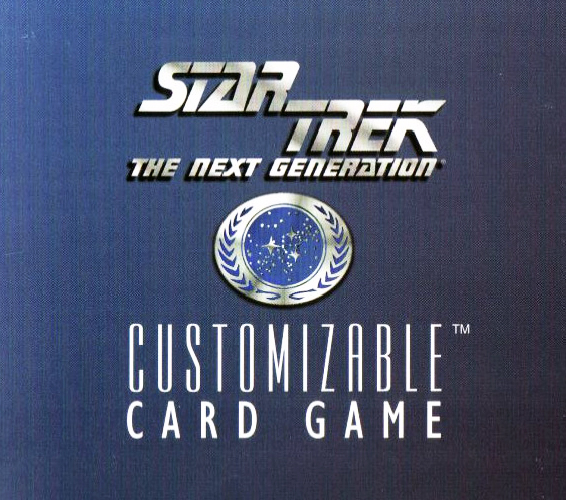
Select from our Star Trek 1E Products Below
Beam me up, Scotty! Arguably the best sci-fi series on TV since, well, ever, Star Trek is a genre that resonates with players and collectors worldwide! One of the first games Decipher Inc. ever produced, Star Trek Customizable Card Game was an adventure like none other. With a massive universe, multiple factions, powerful starships, dilemmas and missions, playing this game was like making our own TV episode of the show every time! As always, Decipher delivered an amazing product with this game, so amazing that it warranted an entire second edition of the game after this one!
Top Sellers
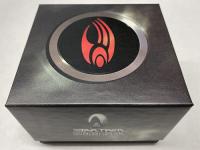
Borg Tournament Deck (OPEN & EMPTY)
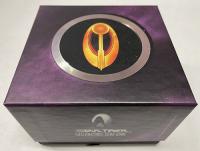
Bajoran Tournament Deck (OPEN & EMPTY)
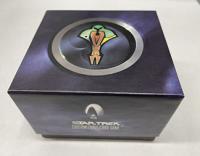
Cardassian Tournament Deck Box (OPEN & EMPTY)
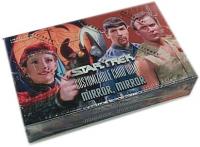
Mirror, Mirror Booster Box
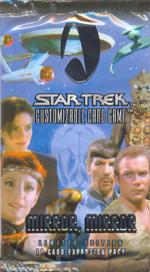
Mirror, Mirror Booster Pack
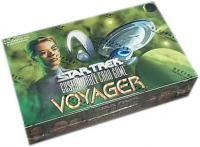
Voyager Booster Box
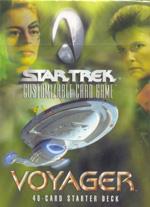
Voyager Starter Deck
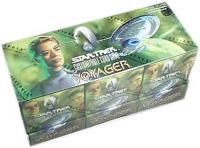
Voyager Starter Deck Box
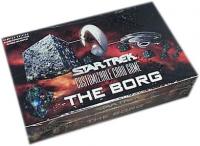
The Borg Booster Box
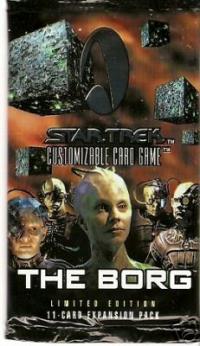
The Borg Booster Pack
- release date
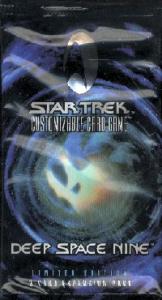
Deep Space 9
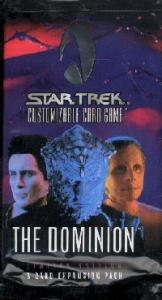
The Dominion
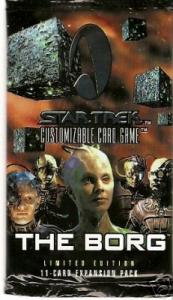
Holodeck Adventures
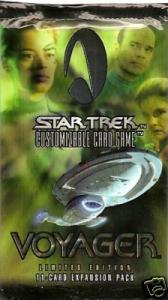
Star Trek 1E Sealed Product

1E Premiere - Limited
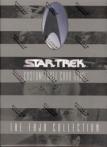
Fajo Collection
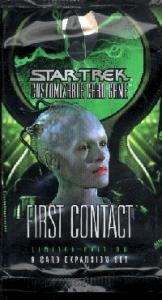
First Contact
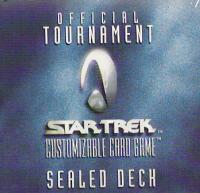
Official Tournament Sealed Deck
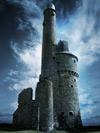
Enhanced First Contact
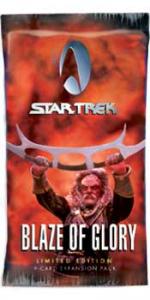
Blaze of Glory
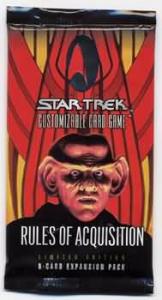
Rules of Acquisition

Second Anthology
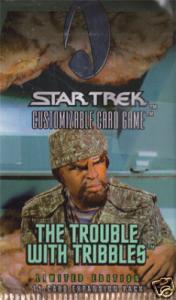
The Trouble with Tribbles
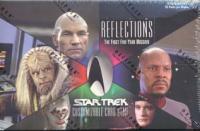
Reflections 1
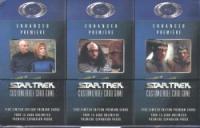
Enhanced Premiere
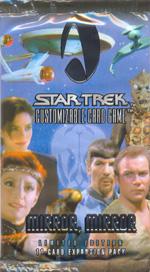
Mirror, Mirror
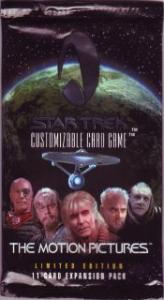
The Motion Pictures
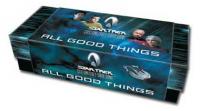
All Good Things
Kicking off the game was just the basic Premiere Set. With 363 cards this set included all the main staples of the Star Trek universe - Jean Luc Picard, Beverly Crusher, Data, Geordi, Worf, and all the other fan favorites of the Enterprise! The game works by selecting a faction to play, such as Klingon, Romulan, Federation, etc. Build up your deck with starships, weapons and crew members, and venture out into the universe. Opponents use dilemas, events, and other problems to throw at you, and attempt to steer you off course, or destroy your efforts, all while you try to complete missions and win the game! Not long after the Premiere set, another great set Alternate Universe expanded the game into a whole new world. Focusing on some other never before seen elements of the Star Trek universe, players had a whole new world opened to them. This set also saw the first ultra rare star trek ccg Card, Future Enterprise. Still an amazing collector’s item, this card can only be found in approximately every 3-6 boxes! The Official Tournament Sealed Deck came out not long after that, providing players an opportunity to take six random packs, plus a preset deck of cards, and try their luck at winning with a blind set of cards! The sets just keep coming out after this - some special Anthology sets were released, an Enhanced Premiere and Enhanced First Contact! Reflections added a whole new world to the game, with special foil versions of many of the popular early cards in the game, including four ultra rare foils to collect such as Future Enterprise and Borg Queen! Later sets included some alternate adventures from different series, such as The Motion Pictures set, Voyager, Holodeck Adventures, and The Trouble with Tribbles. The last set of the first edition, All Good Things, came out as a special edition, and is extremely are and hard to find! Look for all your favorite characters, starships, aliens and dilemmas on our site!
We're becoming a community project. Find out more...
Star trek ccg first edition.
Description
The Star Trek Customizable Card Game is an out-of-print collectible card game based on the Star Trek universe. The name is commonly abbreviated as STCCG or ST:CCG. It was first introduced in 1994 by Decipher.
The standard central goal for a player of STCCG is to obtain 100 points, primarily by completing missions or objectives. This is done by bringing personnel, ships and equipment into play, then moving an attempting team to a mission. Once a mission attempt starts, the personnel will create away teams to encounter dilemmas which will challenge them in some way. Often if the personnel have the required skills or attributes they can overcome certain dilemmas' effects. Once the required dilemmas are passed, the personnel still active in the attempt must have the skills and/or attribute totals required by the mission to solve it. If the mission is solved, the player earns the printed points.
Other aspects of the game increase player interactions: ships and personnel can battle, or otherwise affect each other; cards like events and interrupts can alter the environment for one or more players; and points can be scored using methods other than mission solving.
One of the most attractive themes of the game is affiliations. These are groupings of ships and personnel based on the major interstellar powers of the Star Trek universe, and decks will be based around one, or perhaps more, of these groups.
Following a wish to streamline gameplay, Decipher ended production of First Edition in December 2007 and launched Star Trek CCG Second Editon .

The Continuing Committee
Following Decipher's ceasing production of Star Trek CCG, a group of players formed "The Continuing Committee" to continue to release fan expansions and to oversee tournaments. To date, they have released more content for the game than Decipher did! They support both First and Second editions of the Star Trek CCG. Their expansions add great variety, depth and balance, while still holding true to the spirit of the original games.
The official website of "The Continuing Committee" for Star Trek First Edition is www.trekcc.org/1e .
If you like what they do, consider supporting their work here .
Star Trek CCG First Edition Database
Below is a complete database of the Star Trek CCG First Edition. Click on one of the sets below to view the cards in that set. Click on a card to add it for sale, trade or a wishlist / collection. If you find any errors in the database, please contact us using the feedback form at the bottom of the page.
Star Trek CCG 1E: Limited Edition
November 1994
December 1995
October 1996
January 1999
August 1999
December 1999
August 2000
December 2000
September 2001
December 2001
Star Trek CCG 1E: Unlimited Edition
December 1994
Star Trek CCG 1E: Starters & Anthologies
January 1997
December 1998
November 2000
Star Trek CCG 1E: Promos & Tournament Packs
December 1997
October 1995
February 2000
October 2000
Connect with us
- Mobile Site
- Staff Directory
- Advertise with Ars
Filter by topic
- Biz & IT
- Gaming & Culture
Front page layout
Live long and prosper —
How a star trek card game quietly continues, 10 years after its official end, video: stccg is now free to play, the continuing committee makes new cards, too.
Cyrus Farivar - Dec 30, 2017 1:30 pm UTC
Earlier this year, I was back at my childhood home in Southern California, digging through some old boxes. Amidst assorted baseball cards, long-forgotten school projects, sports trophies, and more, I located a small, slender white cardboard box.
The box is unmarked, except for a small sticker in the top left-hand corner with my name on it. But I knew what it was the instant I saw it: my entire collection of Star Trek Customizable Card Game (STCCG) , probably a couple hundred cards in total.
While I never had any A-List cards (I never lucked out on any Enterprise bridge crew for instance), I quickly found the few that I set aside in plastic sleeves: Lt. Jg. Jean-Luc Picard, Montgomery Scott, and even Mot the Barber. Nostalgia washed over me. The cards were just as I had left them, likely more than two decades ago, replete with slips of paper marking the different types: "Missions," "Equipment," "Federation Ships," and more. This box hadn't been opened since I put them away back in high school.
- Behold—wonder awaits those who find cardboard boxes at their parents' house. Cyrus Farivar
- An assortment of the author's 1E collection. Cyrus Farivar
- Why is the Federation worse at planetary shields than Klingons or Romulans? Cyrus Farivar
- Chaotic Bro!
- Apparently this was a valuable card back in the day? Cyrus Farivar
- This was the closest I ever got to getting an Enterprise card. Cyrus Farivar
- Even Q is here, too. Cyrus Farivar
Somewhere along the way, I had just stopped playing—I grew older, plus I never knew that many people who also played CCG. Its community paled in comparison (in terms of size at least) to deck-building card games that broke into the mainstream like Magic: The Gathering or Pokemon. These days, many people likely would never even have known this game once existed if not for "The Greatest Generation" podcast. As a regular-listening fan, I sent them some packs from eBay back in April. By summer, those packs became part of a new comedy bit on the show.
Further Reading
Nevertheless, I took those cards home after finding them that day. Months later, they sat dormant, a victim of the same old problems. I still didn't have anyone to play with. Worse still, I didn't even remember how to play. And that's when I finally turned to the Internet on one quiet afternoon. Eventually, I discovered three amazing facts.
First, CCG is officially dead, its last official expansion pack was released in December 2007. However, a group of dedicated CCG fans have banded together online not only to keep its memory alive, but to play and organize tournaments an entire decade later.
Second, that group, which calls itself the Continuing Committee , creates new cards to add to the existing universe. And lastly, with the game out of print for so long and the original publishing company on financial life support, CCG is now entirely free to play.
This means you, fellow Star Trek fan, can combine an online deck builder, a printer, and some plastic card sleeves to be playing within hours . And a vibrant, welcoming community keeping this game alive will be ready and waiting.
License to nerd
I started my trip down CCG memory lane like I would any nostalgia trip: Wikipedia . As you might expect based on the dedication this card game seems to inspire, the entry on CCG is robust: it outlines the myriad expansion packs that came out long after I stopped playing, circa 1996, including First Contact and Enterprise Edition . The very bottom of the Wikipedia entry first introduced me to the Continuing Committee (CC), but I still had more questions than answers. What was the lasting appeal of this game; have I been missing out? And if I did get back into it, could I use the cards I already had?
Looking at the Continuing Committee website, it's clear this represents a labor of love. The site didn’t render very nicely on my iPhone. The " About Us " page was simply an org chart. But despite its archaic and cluttered design, everything appeared to be active. Players were to this very date organizing themselves into tournaments in locales as varied as a jazz club in Vienna, Austria and a Panera Bread in Highland Heights, Ohio. A link at the bottom of the site labeled "Rulebook" linked to a six-page PDF outlining how to play what appeared to be a spinoff game, Tribbles. I was nowhere closer to re-learning the actual STCCG game, but I certainly was on to something.
Eventually, I connected with Maggie Geppert, a 37-year-old physics professor at Harper College in Palatine, Illinois . She's the new acting director of operations at the Continuing Committee, and she graciously connected with some card-finding stranger for a nearly two-hour phone call. I started by explaining my situation and describing the cards now strewn across my desk.
"You have First Edition cards," she patiently told me. In CCG lingo, these are known as "1E" cards.
"1E has to play other 1E," Geppert said. The first edition of the game still draws players—with a new expansion appearing on January 12, 2018—though Second Edition generally has more.
So while my cards were neat keepsakes, I would want to get hold of some 2E cards to really explore playing again.
Decipher Inc., the Virginia-based publisher of CCG, released the first edition and ran with those cards from 1994 until 2002. At that point, the game was redesigned to make it modern and more streamlined. (Decipher’s more popular card game, Star Wars: The Customizable Card Game , which ran from 1995 until 2001, has spawned a similar fan site, also called the Continuing Committee.) The company evidently had concerns about the bloat and complexity that built up with 1E over time, and this made the game harder to learn and caused gameplay imbalances in certain ways. 2E ran for another five years before, as Geppert explained, "Decipher lost their license," and the game ceased production in 2007.
While I appreciated the history lesson, I was admittedly crestfallen. I couldn’t use the cards I already had? I had to scour eBay for 2E cards, which seemingly were a bit more expensive than 1E cards?
I didn’t need to spend a dime, Geppert reassured me. With the license a thing of the past, the CC currently offers a full list of printable cards, pre-made decks, and even an online deck builder. Most people don’t play with officially made cards anymore, she said. They simply color print the ones they want and slide them in front of old CCG cards (or even Magic: The Gathering cards) in a plastic sleeve.
"We discourage people from printing them on cardstock because they are indistinguishable from cards that were produced—that would get us in trouble," she said.
Geppert remained encouraging—I could learn again. She explained that she was taught the game by some friends back in college.
"They were like, 'Here take all these extra cards, learn the game and you should come play with us,'" she said. "We had bonded over Star Trek . My Dad and my Mom are both big Star Trek fans. I’d already watched TNG —I loved DS9 —having this game that I could play with my friends was a lot of fun. We would sit around on Friday nights and watch Spike TV and watch reruns. We’d eat pizza and watch Star Trek and play Star Trek— that was our Friday nights."
Geppert was speaking my language: most of my freshman year at UC Berkeley, Saturday nights at midnight Pacific Time meant diving into my standing IRC Star Trek role playing game.
Eventually, Geppert found players as she moved around the US, in Boston and then greater Chicago. Years later, she found the CC and eventually rose through its all-volunteer ranks. The group, which has existed solely as a group of fellow fans with a website to date, is in the process of incorporating as a formal 501(c)3 nonprofit organization.
While the most conventional way is to play one on one, there are experimental ways to play multiplayer. The CC tournaments are a series of one-on-one games, sometimes held on the sidelines of GenCon or other conventions. But more often than not, they’re held at people's homes. Geppert said she recently brought her husband and two young children on a road trip to Denison, Texas, to play in a weekend tournament. In essence, it’s a big, nerdy party no matter the venue.
"It’s 22 people sitting at plastic folding tables in a guy’s living room, eating fried chicken, drinking a lot of alcohol, and taunting each other," she said. "Some of them were new to me, or I’d only known them online. We had a guy from Minnesota, some guys from the DC area, New Jersey, Florida, Georgia, and even the UK."
The physics professor clearly sees a lasting appeal of Decipher’s original game, and she said that by introducing new CC-sanctioned cards, it "keeps the game continually interesting." She sees traffic on the CC website die down if it has been awhile since a newly created expansion, for instance. But to that, Geppert mentioned that there were no current plans to include anything from the J.J. Abrams films or the new series, Star Trek: Discovery, out of an abundance of caution.
"We have decided to play it safe in terms of the new material. We think we’re pretty safe in terms of staying on the legal side and keeping eyes off us if we stick with the shows that Decipher had a license for," she says. "They had license for the five shows and 10 movies including Nemesis . [Using that], we try to keep to a rough schedule of a new release every four months."
She estimated that the CC has "a few hundred active players" spread across the globe, with "big playgroups" in Chicago, Boston, Atlanta, Charlotte, Minneapolis, Seattle, Vancouver, London, Munich, Vienna, Sydney, and San Diego.
"The game is free, come play it!" she encouraged me.
reader comments
Channel ars technica.

- Toys & Games
- Collectible Toys
- Collectible Display & Storage
- Card Storage & Display

Image Unavailable

- To view this video download Flash Player
- Star Trek Card Game Booster Pack Set - Bundle with 6 Star Trek Customizable Card Game White Border Packs for Kids, Adults (Trek Card Game)
About this item
- This Star Trek trading cards set comes with 6 Customizable Card Game White Border Card Booster Sets (15 cards each), 60 cards total!
- Sure to be a hit with Star Trek fans of all ages, this trading card game starter pack is great to give as a gift to the Star Trek fan in your life.
- Perfect for you and a friend, this Star Trek trading cards set comes with all the necessary components to start the game and collect cards featuring your favorite Star Trek characters!
- Officially licensed Star Trek trading card game starter pack is perfect for fans of all ages, boys and girls, kids and adults alike.
Customers who bought this item also bought

Product information
Product description.
Star Trek Card Game Booster Pack Set - Bundle with 6 Star Trek Customizable Card Game White Border Packs for Kids, Adults (Trek Card Game). This Star Trek trading cards set comes with 6 Customizable Card Game White Border Card Booster Sets (15 cards each), 60 cards total! Sure to be a hit with Star Trek fans of all ages, this trading card game starter pack is great to give as a gift to the Star Trek fan in your life. Perfect for you and a friend, this Star Trek trading cards set comes with all the necessary components to start the game and collect cards featuring your favorite Star Trek characters! Officially licensed Star Trek trading card game starter pack is perfect for fans of all ages, boys and girls, kids and adults alike.
What's in the box
- star trek gifts, star trek card game, star trek party supplies, star trek trading cards, star trek games board games, star trek party decorations, star trek trading cards box, star trek gifts for men, star trek party favors, star trek trading card game
Looking for specific info?
Customer reviews.
Customer Reviews, including Product Star Ratings help customers to learn more about the product and decide whether it is the right product for them.
To calculate the overall star rating and percentage breakdown by star, we don’t use a simple average. Instead, our system considers things like how recent a review is and if the reviewer bought the item on Amazon. It also analyzed reviews to verify trustworthiness.
Reviews with images

- Sort reviews by Top reviews Most recent Top reviews
Top reviews from the United States
There was a problem filtering reviews right now. please try again later..
Top reviews from other countries
- Amazon Newsletter
- About Amazon
- Accessibility
- Sustainability
- Press Center
- Investor Relations
- Amazon Devices
- Amazon Science
- Sell on Amazon
- Sell apps on Amazon
- Supply to Amazon
- Protect & Build Your Brand
- Become an Affiliate
- Become a Delivery Driver
- Start a Package Delivery Business
- Advertise Your Products
- Self-Publish with Us
- Become an Amazon Hub Partner
- › See More Ways to Make Money
- Amazon Visa
- Amazon Store Card
- Amazon Secured Card
- Amazon Business Card
- Shop with Points
- Credit Card Marketplace
- Reload Your Balance
- Amazon Currency Converter
- Your Account
- Your Orders
- Shipping Rates & Policies
- Amazon Prime
- Returns & Replacements
- Manage Your Content and Devices
- Recalls and Product Safety Alerts
- Conditions of Use
- Privacy Notice
- Consumer Health Data Privacy Disclosure
- Your Ads Privacy Choices

CCG: First Contact
- View history
The First Contact expansion was released in December of 1997. This expansion introduced the Borg Affiliation as well the "Objective" card type. All cards in this expansion were taken from Star Trek: First Contact . Notable cards include "Espionage Mission", set on Earth , new cards for the Next Generation command crew, the inventor of warp drive , and a ship from the past.
- 1 Artifacts
- 4 Equipment
- 6.1 Outpost
- 7 Interrupts
- 9 Objectives
- 10.2 Federation
- 10.3 Non-Aligned
- 11.2 Federation
- 11.3 Non-Aligned
- 12 Time Location
Artifacts [ ]
- Antique Machine Gun
- Magic Carpet Ride OCD
- Zefram Cochrane's Telescope
Dilemmas [ ]
- Balancing Act
- Don't Call Me Ahab
- Lack of Preparation
- My First Raygun
- Primitive Culture
- Scout Encounter
- Shot in the Back
- Strict Dress Code
- Theta Radiation Poisoning
- Undetected Beam-In
Doorways [ ]
- Launch Portal
- Ready Room Door
- Temporal Vortex
- Transwarp Network Gateway
Equipment [ ]
- Assimilation Table
- Starfleet Type III Phaser Rifle
- Abandon Mission
- Activate Subcommands
- Disengage Safety Protocols
- Intermix Ratio
- Mirror Image
- Mission Debriefing
- Ocular Implants
- The Line Must Be Drawn Here
- Wall of Ships
Facility [ ]
Outpost [ ].
- Borg Outpost
Interrupts [ ]
- A Change of Plan
- Adapt: Modulate Shields
- Adapt: Negate Obstruction
- Alas, Poor Queen
- Android Headlock
- Assimilate This!
- Assimilation tubules
- Borg Neuroprocessor
- Deactivation
- Fractal Encryption Code
- He Will Make An Excellent Drone
- I'm A Doctor, Not A Doorstop
- Remodulation
- Scorched Hand
- Sense the Borg
- Temporal Wake
- Three-Dimensional Thinking
Missions [ ]
- Espionage Mission
- Patrol Neutral Zone
Objectives [ ]
- Assign Mission Specialists
- Assimilate Counterpart
- Assimilate Homeworld
- Assimilate Planet
- Assimilate Starship
- Build Interplexing Beacon
- Eliminate Starship
- Establish Gateway
- Prepare Assault Teams
- Salvage Starship
- Stop First Contact
- Visit Cochrane Memorial
Personnel [ ]
- Eight of Nineteen
- Eighteen of Nineteen
- Eleven of Nineteen
- Fifteen of Seventeen
- Five of Eleven
- Four of Eleven
- Nine of Eleven
- Nine of Seventeen
- One of Eleven
- Six of Eleven
- Six of Seventeen
- Sixteen of Nineteen
- Ten of Nineteen
- Thirteen of Nineteen
- Three of Nineteen
- Two of Eleven
- Two of Nineteen
- Two of Seventeen
Federation [ ]
- Admiral Hayes
- Alyssa Ogawa
- Beverly Crusher
- Deanna Troi
- E.M.H. Program
- Geordi La Forge
- Jean-Luc Picard
- Joseph Travis
- Paul Porter
- Reginald Barclay
- Richard Wilkins
- Thomas McClure
- William T. Riker
Non-Aligned [ ]
- Kathleen Tonell
- Lily Sloane
- Zefram Cochrane
- Borg Scout Vessel
- Borg Sphere
- Queen's Borg Cube
- Queen's Borg Sphere
- USS Bozeman
- USS Enterprise
- Vulcan Lander
Time Location [ ]
- Montana Missile Complex
- 1 Abdullah bin al-Hussein
share this!
April 11, 2024
This article has been reviewed according to Science X's editorial process and policies . Editors have highlighted the following attributes while ensuring the content's credibility:
fact-checked
trusted source
Engineers recreate Star Trek's Holodeck using ChatGPT and video game assets
by Ian Scheffler, University of Pennsylvania
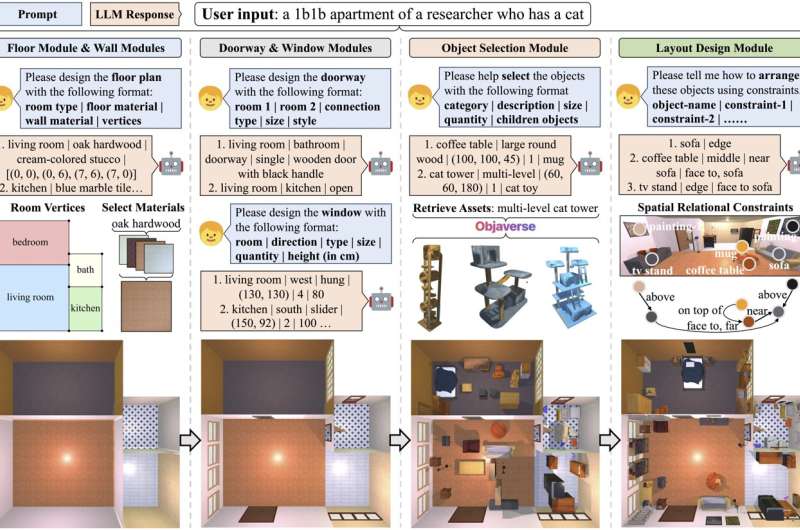
In "Star Trek: The Next Generation," Captain Picard and the crew of the U.S.S. Enterprise leverage the Holodeck, an empty room capable of generating 3D environments, of preparing for missions and entertaining them, simulating everything from lush jungles to the London of Sherlock Holmes.
Deeply immersive and fully interactive, Holodeck-created environments are infinitely customizable, using nothing but language; the crew has only to ask the computer to generate an environment, and that space appears in the Holodeck.
Today, virtual interactive environments are also used to train robots prior to real-world deployment in a process called "Sim2Real." However, virtual interactive environments have been in surprisingly short supply.
"Artists manually create these environments," says Yue Yang, a doctoral student in the labs of Mark Yatskar and Chris Callison-Burch, Assistant and Associate Professors in Computer and Information Science (CIS), respectively. "Those artists could spend a week building a single environment," Yang adds, noting all the decisions involved, from the layout of the space to the placement of objects to the colors employed in rendering.
That paucity of virtual environments is a problem if you want to train robots to navigate the real world with all its complexities. Neural networks, the systems powering today's AI revolution, require massive amounts of data, which in this case means simulations of the physical world.
"Generative AI systems like ChatGPT are trained on trillions of words, and image generators like Midjourney and DALL-E are trained on billions of images," says Callison-Burch. "We only have a fraction of that amount of 3D environments for training so-called 'embodied AI.' If we want to use generative AI techniques to develop robots that can safely navigate in real-world environments, then we will need to create millions or billions of simulated environments."
Enter Holodeck , a system for generating interactive 3D environments co-created by Callison-Burch, Yatskar, Yang and Lingjie Liu, Aravind K. Joshi Assistant Professor in CIS, along with collaborators at Stanford, the University of Washington, and the Allen Institute for Artificial Intelligence (AI2). Named for its Star Trek forebear, Holodeck generates a virtually limitless range of indoor environments, using AI to interpret users' requests.
The paper is published on the arXiv preprint server.
"We can use language to control it," says Yang. "You can easily describe whatever environments you want and train the embodied AI agents."
Holodeck leverages the knowledge embedded in large language models (LLMs), the systems underlying ChatGPT, and other chatbots. "Language is a very concise representation of the entire world," says Yang. Indeed, LLMs turn out to have a surprisingly high degree of knowledge about the design of spaces, thanks to the vast amounts of text they ingest during training. In essence, Holodeck works by engaging an LLM in conversation, using a carefully structured series of hidden queries to break down user requests into specific parameters.
Just like Captain Picard might ask Star Trek's Holodeck to simulate a speakeasy, researchers can ask Penn's Holodeck to create "a 1b1b apartment of a researcher who has a cat." The system executes this query by dividing it into multiple steps: First, the floor and walls are created, then the doorway and windows.
Next, Holodeck searches Objaverse , a vast library of premade digital objects, for the sort of furnishings you might expect in such a space: a coffee table, a cat tower, and so on. Finally, Holodeck queries a layout module, which the researchers designed to constrain the placement of objects so that you don't wind up with a toilet extending horizontally from the wall.
To evaluate Holodeck's abilities, in terms of their realism and accuracy, the researchers generated 120 scenes using both Holodeck and ProcTHOR, an earlier tool created by AI2, and asked several hundred Penn Engineering students to indicate their preferred version, not knowing which scenes were created by which tools. For every criterion—asset selection, layout coherence, and overall preference—the students consistently rated the environments generated by Holodeck more favorably.
The researchers also tested Holodeck's ability to generate scenes that are less typical in robotics research and more difficult to manually create than apartment interiors, like stores, public spaces, and offices. Comparing Holodeck's outputs to those of ProcTHOR, which were generated using human-created rules rather than AI-generated text, the researchers found once again that human evaluators preferred the scenes created by Holodeck. That preference held across a wide range of indoor environments, from science labs to art studios, locker rooms to wine cellars.
Finally, the researchers used scenes generated by Holodeck to "fine-tune" an embodied AI agent. "The ultimate test of Holodeck," says Yatskar, "is using it to help robots interact with their environment more safely by preparing them to inhabit places they've never been before."
Across multiple types of virtual spaces, including offices, daycares, gyms and arcades, Holodeck had a pronounced and positive effect on the agent's ability to navigate new spaces.
For instance, whereas the agent successfully found a piano in a music room only about 6% of the time when pre-trained using ProcTHOR (which involved the agent taking about 400 million virtual steps), the agent succeeded over 30% of the time when fine-tuned using 100 music rooms generated by Holodeck.
"This field has been stuck doing research in residential spaces for a long time," says Yang. "But there are so many diverse environments out there—efficiently generating a lot of environments to train robots has always been a big challenge, but Holodeck provides this functionality."
In June, the researchers will present Holodeck at the 2024 Institute of Electrical and Electronics Engineers (IEEE) and Computer Vision Foundation (CVF) Computer Vision and Pattern Recognition (CVPR) Conference in Seattle, Washington.
GitHub: yueyang1996.github.io/holodeck/
Explore further
Feedback to editors

Researchers develop sodium battery capable of rapid charging in just a few seconds
7 hours ago

Greater access to clean water, thanks to a better membrane
9 hours ago

Silent flight edges closer to take off, according to new research

A flexible and efficient DC power converter for sustainable-energy microgrids
10 hours ago

Microsoft's AI app VASA-1 makes photographs talk and sing with believable facial expressions

To build a better AI helper, start by modeling the irrational behavior of humans

Versatile fibers offer improved energy storage capacity for wearable devices
11 hours ago

Harnessing solar energy for high-efficiency NH₃ production
12 hours ago

A dexterous four-legged robot that can walk and handle objects simultaneously
13 hours ago

Climate change will increase value of residential rooftop solar panels across US, study finds
15 hours ago
Related Stories

A holodeck for flies, fish and mice
Aug 21, 2017

A multisensory simulation platform to train and test home robots
Jun 16, 2023

We created holograms you can touch: You could soon shake a virtual colleague's hand
Sep 17, 2021

Opening new doors in the VR world—literally
Mar 13, 2024

Amazon creates a new user-centric simulation platform to develop embodied AI agents
Apr 11, 2023

An embodied conversational agent that merges large language models and domain-specific assistance
Sep 13, 2023
Recommended for you

Team develops a way to teach a computer to type like a human
Apr 18, 2024

Using sim-to-real reinforcement learning to train robots to do simple tasks in broad environments

Meta's newest AI model beats some peers. But its amped-up AI agents are confusing Facebook users
Let us know if there is a problem with our content.
Use this form if you have come across a typo, inaccuracy or would like to send an edit request for the content on this page. For general inquiries, please use our contact form . For general feedback, use the public comments section below (please adhere to guidelines ).
Please select the most appropriate category to facilitate processing of your request
Thank you for taking time to provide your feedback to the editors.
Your feedback is important to us. However, we do not guarantee individual replies due to the high volume of messages.
E-mail the story
Your email address is used only to let the recipient know who sent the email. Neither your address nor the recipient's address will be used for any other purpose. The information you enter will appear in your e-mail message and is not retained by Tech Xplore in any form.
Your Privacy
This site uses cookies to assist with navigation, analyse your use of our services, collect data for ads personalisation and provide content from third parties. By using our site, you acknowledge that you have read and understand our Privacy Policy and Terms of Use .
E-mail newsletter

IMAGES
VIDEO
COMMENTS
The Continuing Committee is looking for new Board Member. Apply to host a Regional Championship today! Star Trek Customizable Card Game lives on under the Continuing Committee. We create virtual 1E, 2E and Tribble cards. Join for local and online games.
The Star Trek Customizable Card Game is an out-of-print collectible card game based on the Star Trek universe. The name is commonly abbreviated as STCCG or ST:CCG.It was first introduced in 1994 by Decipher, Inc., under the name Star Trek: The Next Generation Customizable Card Game. The game now has two distinct editions, though both forms of the game have many common elements.
A customizable card game (CCG) set in the Star Trek universe. Players play ships and crewmembers and attempt to "solve" or complete missions at discrete "locations" while preventing their opponent from completing them. First player to 100 points, or with the most points when one player's deck runs out, wins. Spinoffs include Tribbles Customizable Card Game See also the 1996 release from Fleer ...
The Star Trek Customizable Card Game (First Edition) is a universe of over 4200 different cards, representing people, places, events, equipment, missions, and more from Gene Roddenberry's Star Trek universe. This game was published on physical cards by Decipher, Inc. from 1994 until 2003. You can still purchase many of the cards Decipher ...
Relive twenty years of the Star Trek Customizable Card Game with The 20th Anniversary Collection, a special eighteen (18) card celebration of Second Edition's history. Featuring cards inspired by each Decipher-era product and from the most recent Continuing Committee expansions, everyone will find a way to relive old memories and build new ones ...
The Star Trek Customizable Card Game is a competitive strategy game set in the Star Trek universe and produced by Decipher. Each card represents an element of the Star Trek universe, such as a starship, a character, a planet or space mission, or an event. Winning involves strategy both during a game session and before playing, through the preparation of an effective play deck, chosen from a ...
The Star Trek Customizable Card Game is a CCG with elements of strategy, knowledge, and a bit of luck. It's based on the Star Trek universe, and it's pretty cool if you ask me. The game was first released back in 1994 by Decipher, Inc. It's not just about battles but also about missions, diplomacy, and exploration, just like in the Star ...
Star Trek CCG 2nd edition is a reinvention of the original star trek customizable card game. One major difference in Second Edition was the addition of a cost system to equipment, events, personnel, and ships. A card's cost is listed in the top left-hand corner of a card, directly preceding the card's title as a single digit number (currently anywhere from 0 to 9).
AQUARIUS Star Trek Original Series Playing Cards - Star Trek Original Series Themed Deck of Cards for Your Favorite Card Games - Officially Licensed Star Trek Merchandise & Collectibles 4.7 out of 5 stars 81
The Star Trek Customizable Card Game is a collectible card game based on the Star Trek universe. The name is commonly abbreviated as STCCG or ST:CCG. It was first introduced in 1994 by Decipher, Inc., under the name Star Trek: The Next Generation Customizable Card Game. The game now has two distinct editions, though both forms of the game have many common elements. The standard central goal ...
The Star Trek Customizable Card Game is a collectible card game based on the Star Trek universe. The name is commonly abbreviated as STCCG or ST:CCG. It was first introduced in 1994 by Decipher, Inc., under the name Star Trek: The Next Generation Customizable Card Game. The game now has two distinct editions, though both forms of the game have ...
Description. Expansion to the base set that introduced the Original Series and the "tribbles" side deck as well as introducing a format change to the cards that included listing card number and rarity in the lower right corner. Special features include pre-constructed starter decks with premium cards in each and the return of ultra-rare cards ...
The Star Trek: Customizable Card Game universe gets a whole lot bigger with Homefront VI, the first Core Block expansion built from the ground up with Block play in mind. Forty-eight (48) newly printable cards combining the old with the converted, focused on adding new and exciting dilemmas to the mix. Download this Virtual Expansion!
Select from our Star Trek 1E Products Below. Beam me up, Scotty! Arguably the best sci-fi series on TV since, well, ever, Star Trek is a genre that resonates with players and collectors worldwide! One of the first games Decipher Inc. ever produced, Star Trek Customizable Card Game was an adventure like none other.
The Star Trek Customizable Card Game is an out-of-print collectible card game based on the Star Trek universe. The name is commonly abbreviated as STCCG or ST:CCG. It was first introduced in 1994 by Decipher. The standard central goal for a player of STCCG is to obtain 100 points, primarily by completing missions or objectives. This is done by ...
The Star Trek Customizable Card Game is an out-of-print collectible card game based on the Star Trek universe. The name is commonly abbreviated as STCCG or ST:CCG. It was first introduced in 1994 by Decipher, Inc., under the name Star Trek: The Next Generation Customizable Card Game. The game now has two distinct editions, though both forms of the game have many common elements.
(Decipher's more popular card game, Star Wars: The Customizable Card Game, which ran from 1995 until 2001, has spawned a similar fan site, also called the Continuing Committee.) The company ...
Star Trek Card Game Booster Pack Set - Bundle with 6 Star Trek Customizable Card Game White Border Packs for Kids, Adults (Trek Card Game). This Star Trek trading cards set comes with 6 Customizable Card Game White Border Card Booster Sets (15 cards each), 60 cards total! Sure to be a hit with Star Trek fans of all ages, this trading card game ...
14th May 2020. Welcome to TrekCC! Let me (re)introduce you to the next game that you want to play: Star Trek Customizable Card Game. The game itself dates back all to the way to 1994 when Decipher, Inc came out with Star Trek The Next Generation Customizable Card Game and continued onward from there through many sets, a new edition, many more ...
This is a list of cards from First Contact, a series of the Star Trek Customizable Card Game: First Edition from Decipher. The First Contact expansion was released in December of 1997. This expansion introduced the Borg Affiliation as well the "Objective" card type. All cards in this expansion were taken from Star Trek: First Contact. Notable cards include "Espionage Mission", set on Earth ...
1996 Star Trek - The Card Game - [Base] #_NoN Core Crew - Dr. Leonard H. "Bones" McCoy. 2 from . $12.61. 2001 Star Trek CCG: Voyager - [Base] #117 Chakotay (Federation) $26.69. 2001 Star Trek CCG: Holodeck Adventures - [Base] #115 Sherlock Holmes. $26.69. 2000 Star Trek CCG: Armada Video Game Promo - [Base] #USSJ ...
Classification. Expansion to the base set that introduced the Delta Quadrant faction of Voyager and her crew as well as the Kazon and Vidiian affiliations. Starting with this expansion, dual-affiliation cards were printed with both color borders (with equal rarity). The set included 201 cards and was available in 40-card starter decks (some of ...
In "Star Trek: The Next Generation," Captain Picard and the crew of the U.S.S. Enterprise leverage the Holodeck, an empty room capable of generating 3D environments, of preparing for missions and entertaining them, simulating everything from lush jungles to the London of Sherlock Holmes.
This version of the STAR TREK CCG Second Edition rulebook was released in April 2015. It replaces and supersedes the previous rulebook. T he Continuing Committee is dedicated to not only maintaining the Star Trek: Customizable Card Game community and the levels of competition, but exceeding them in scope and in quality.